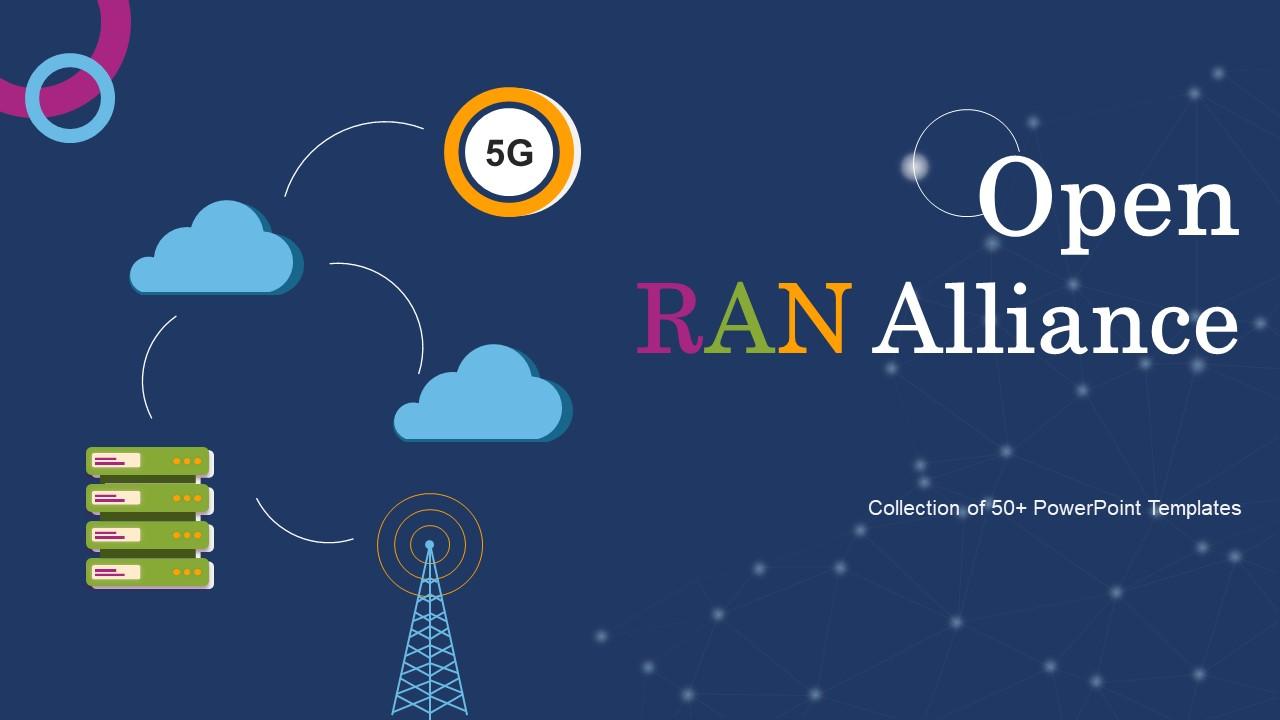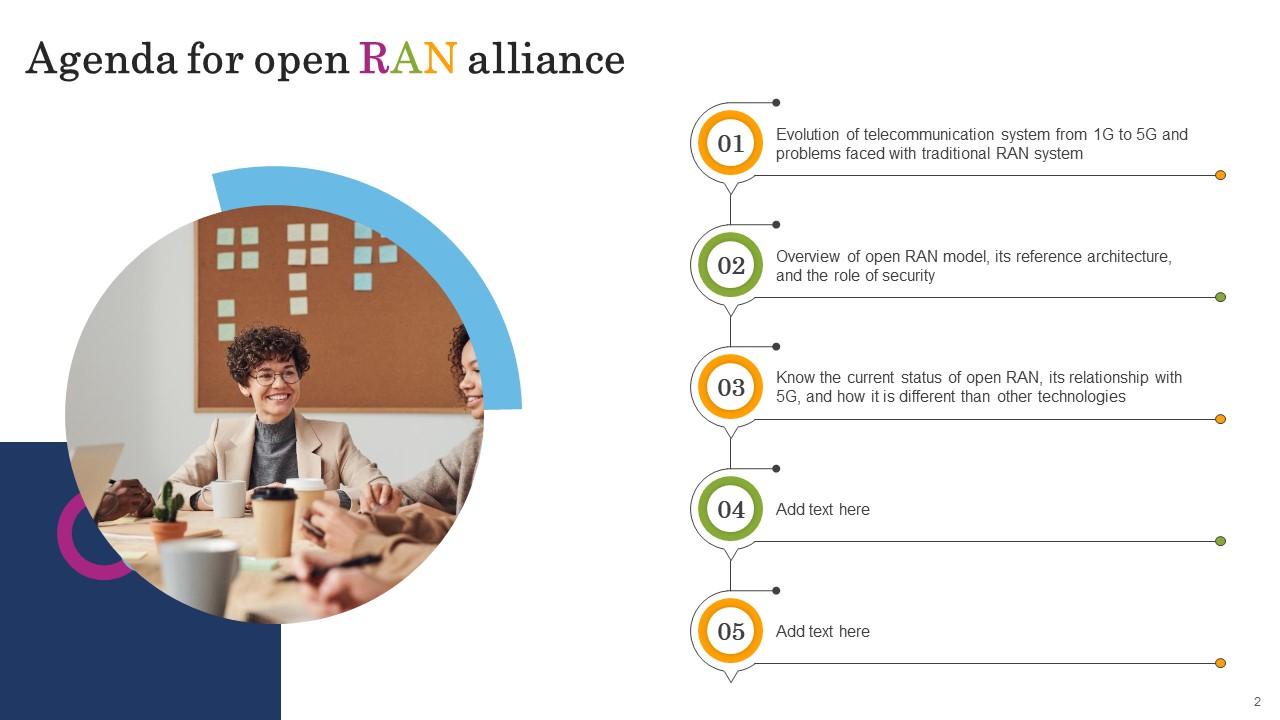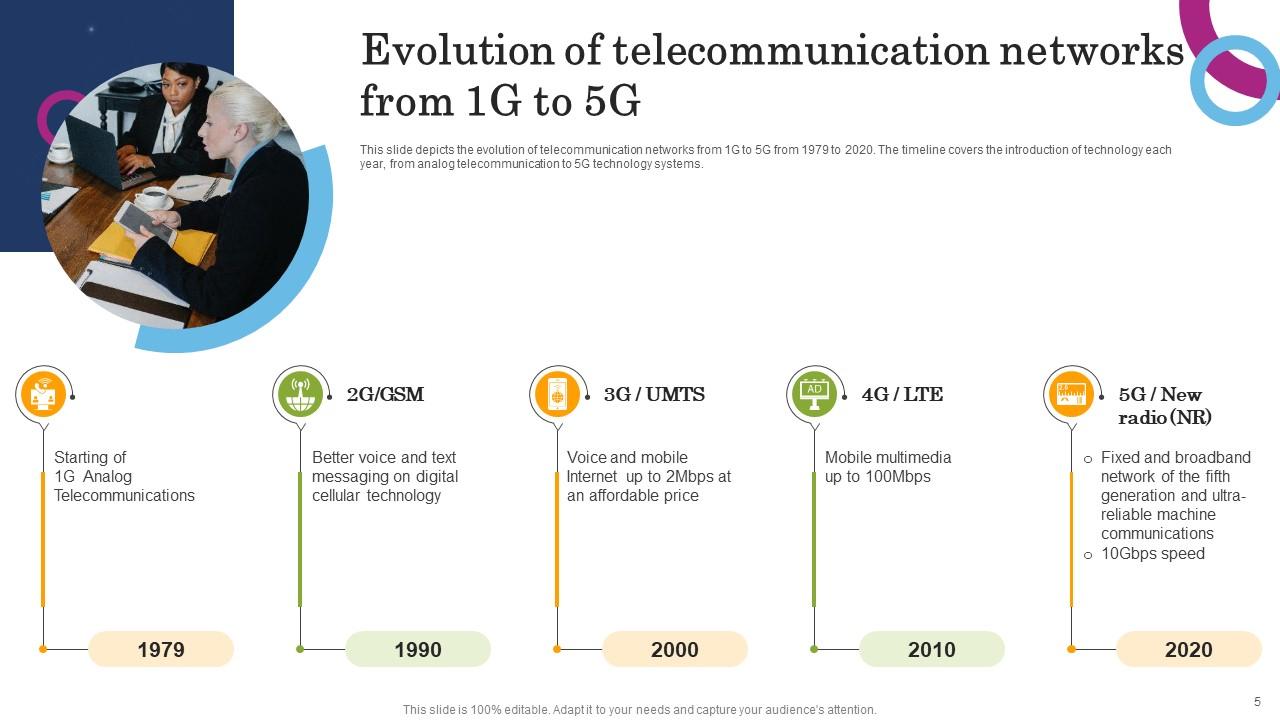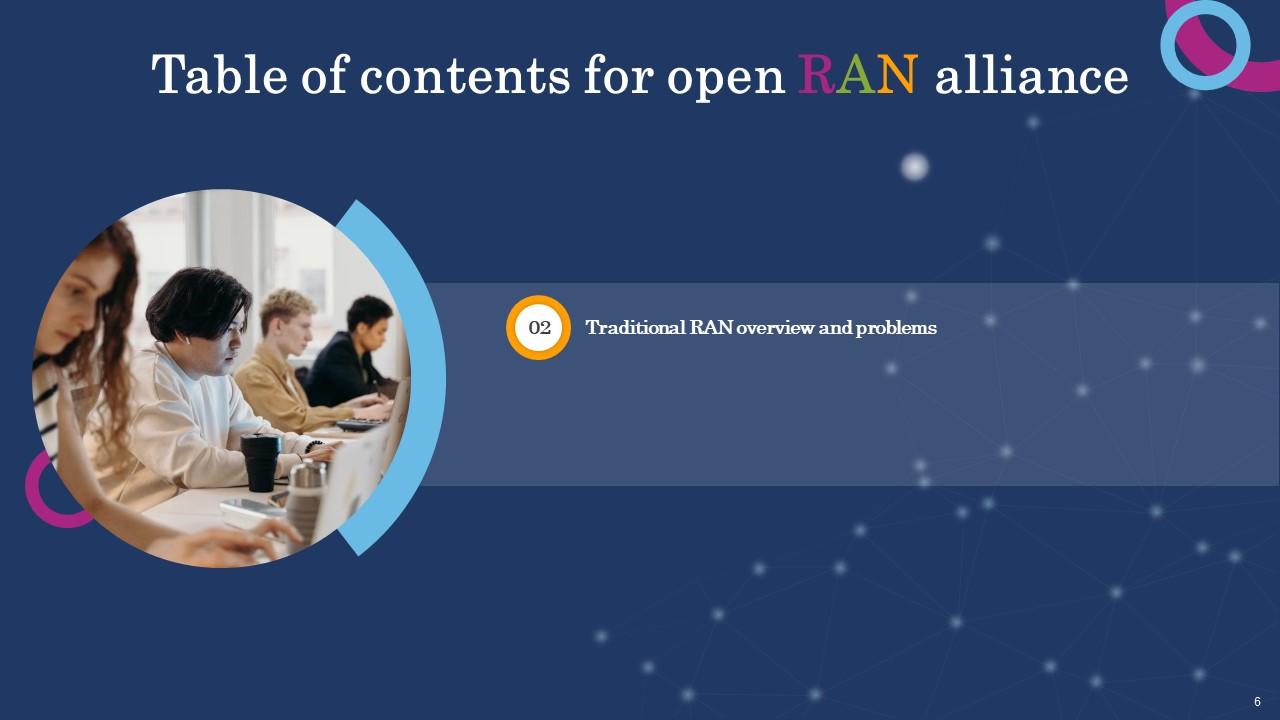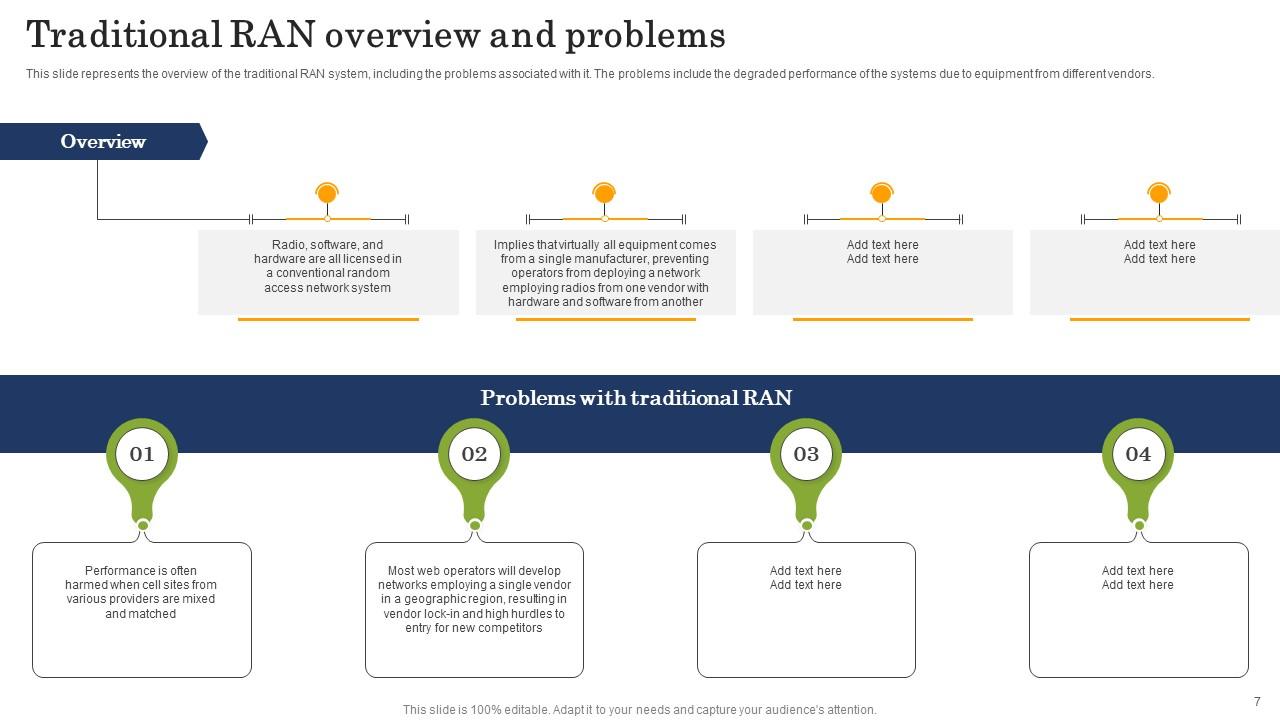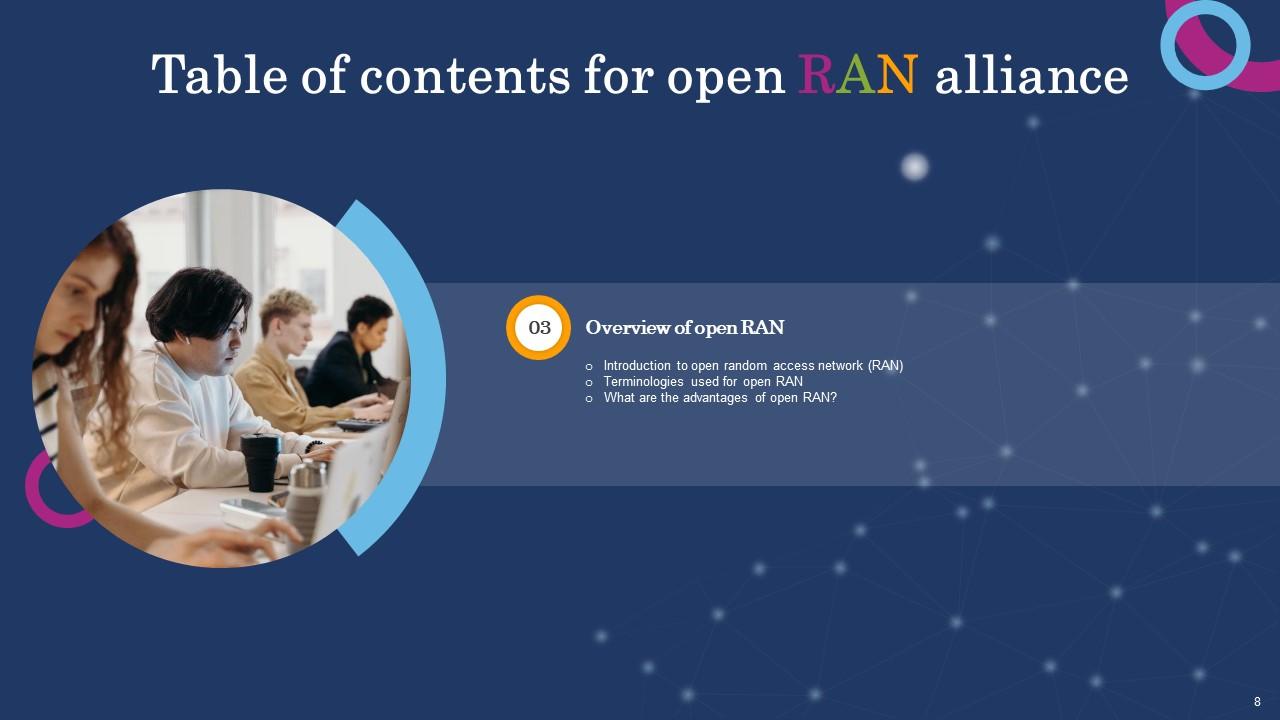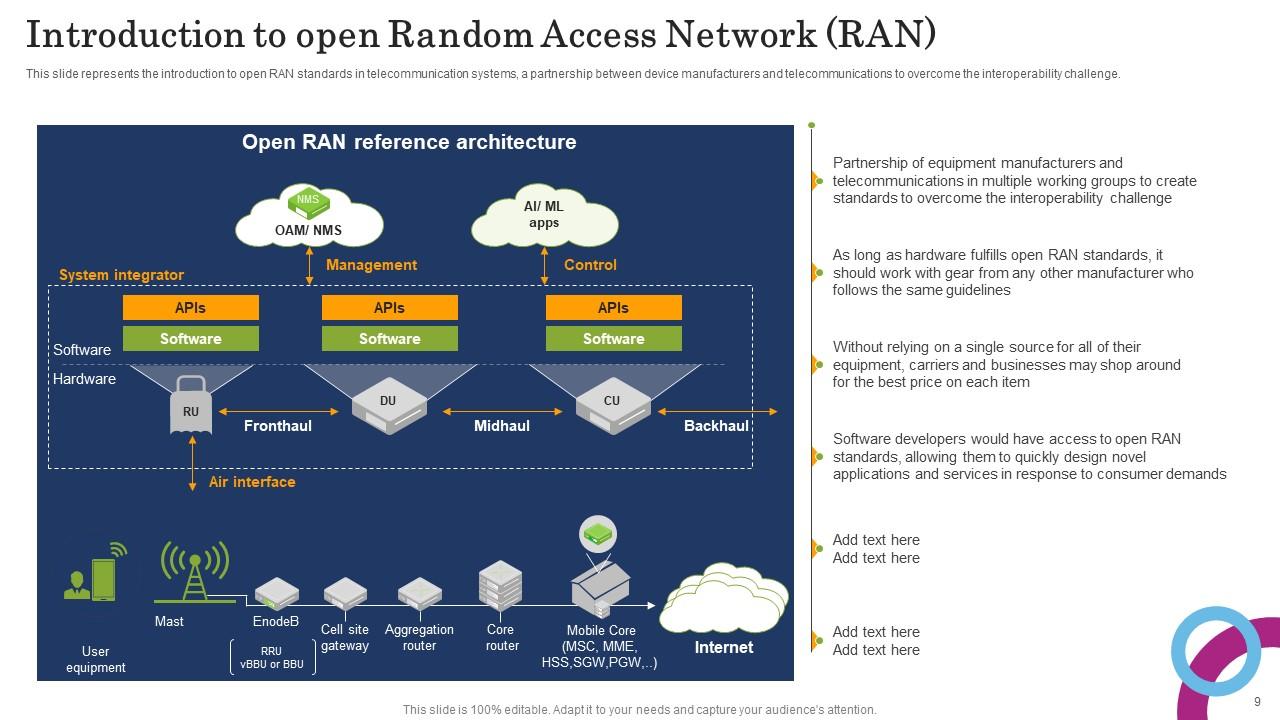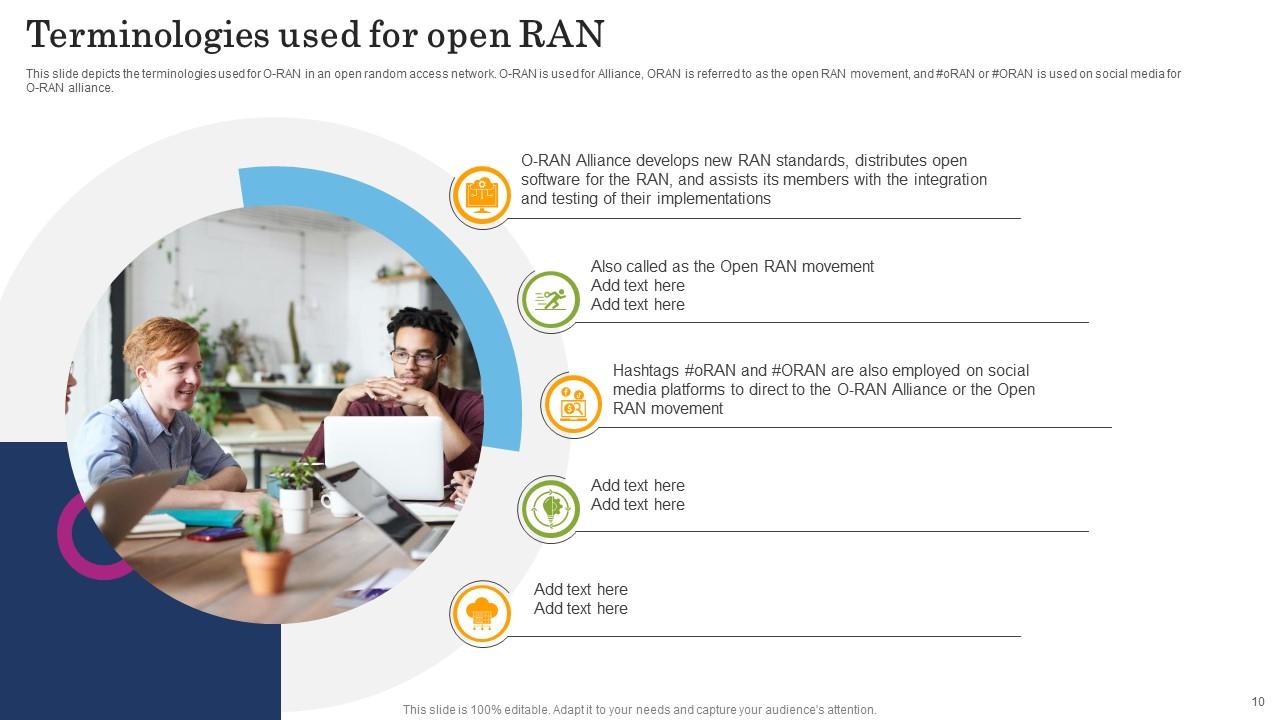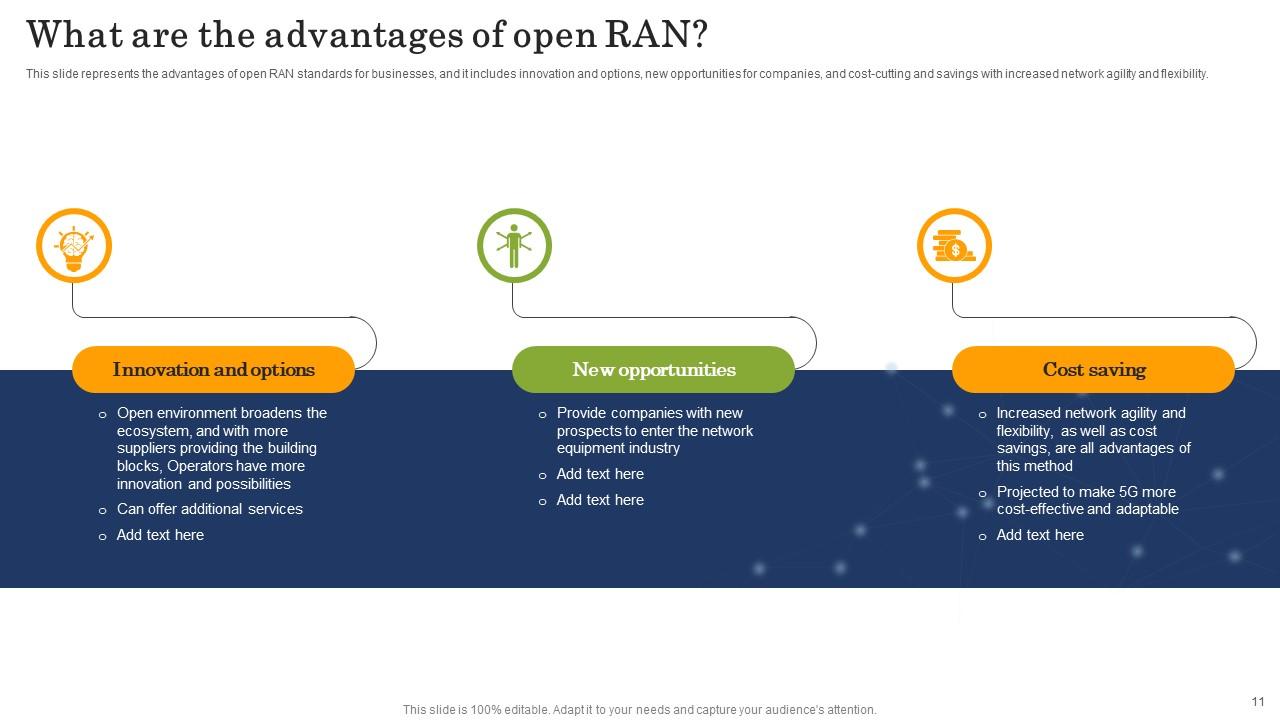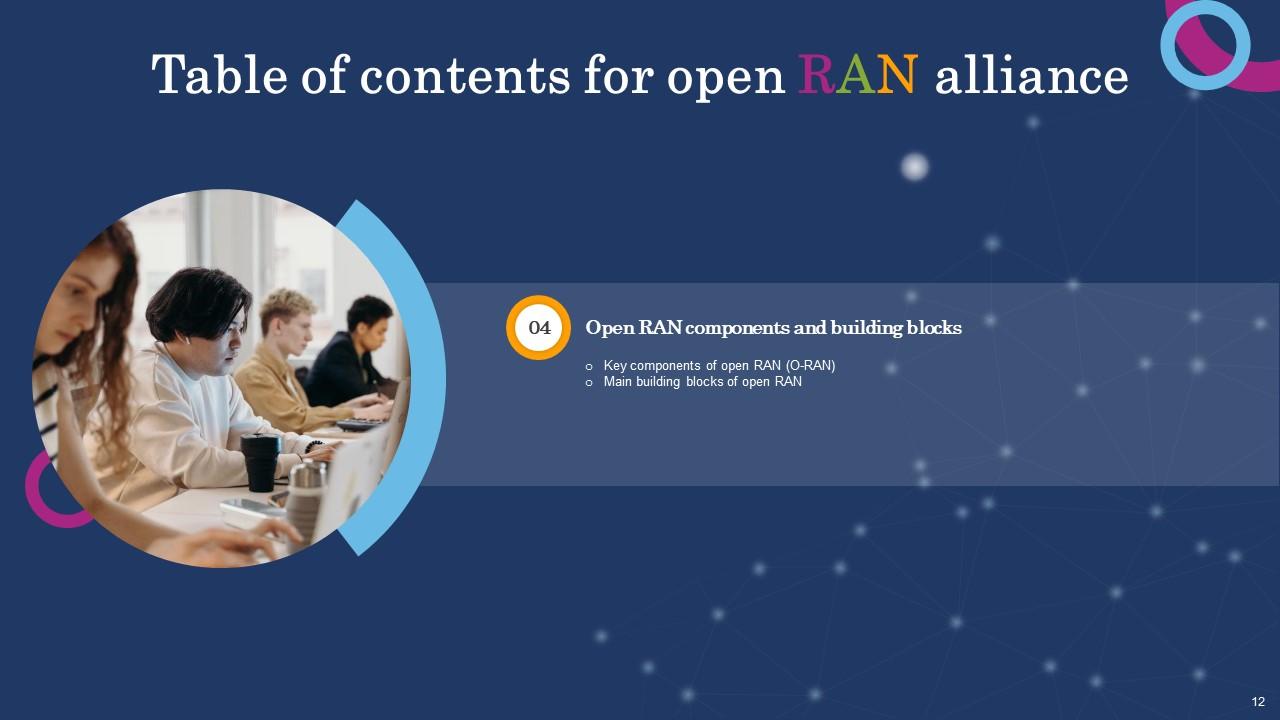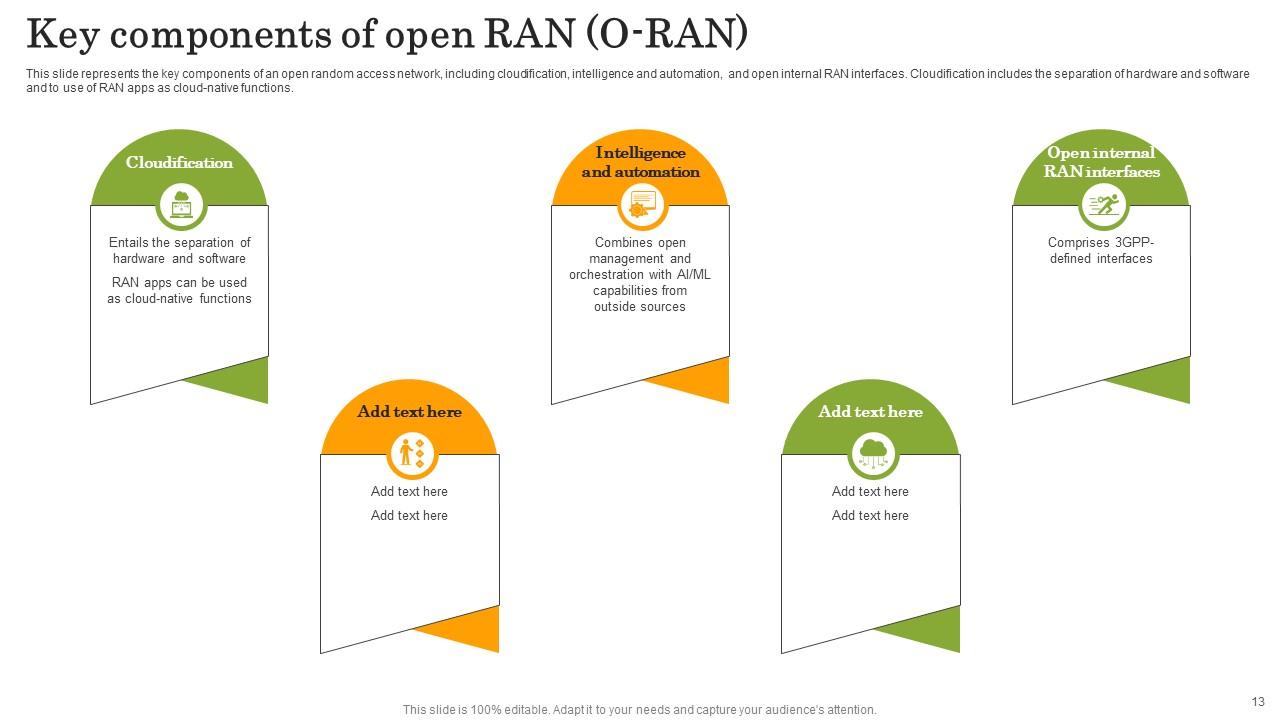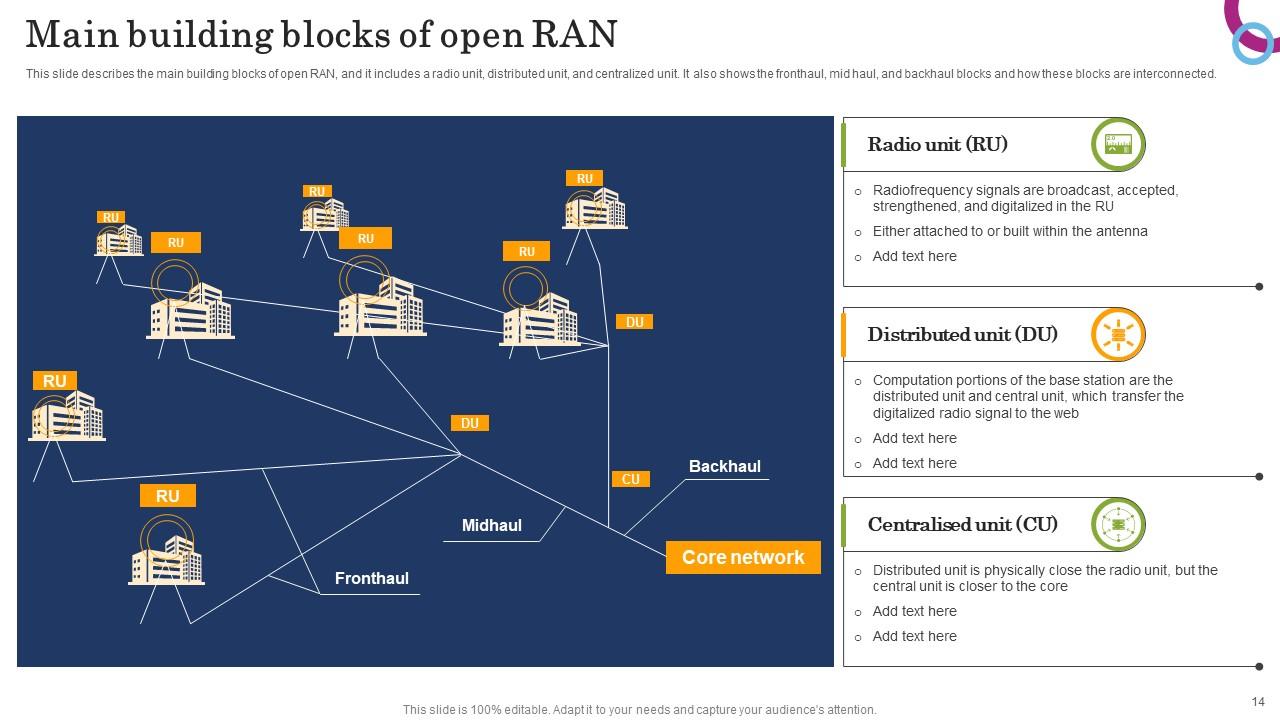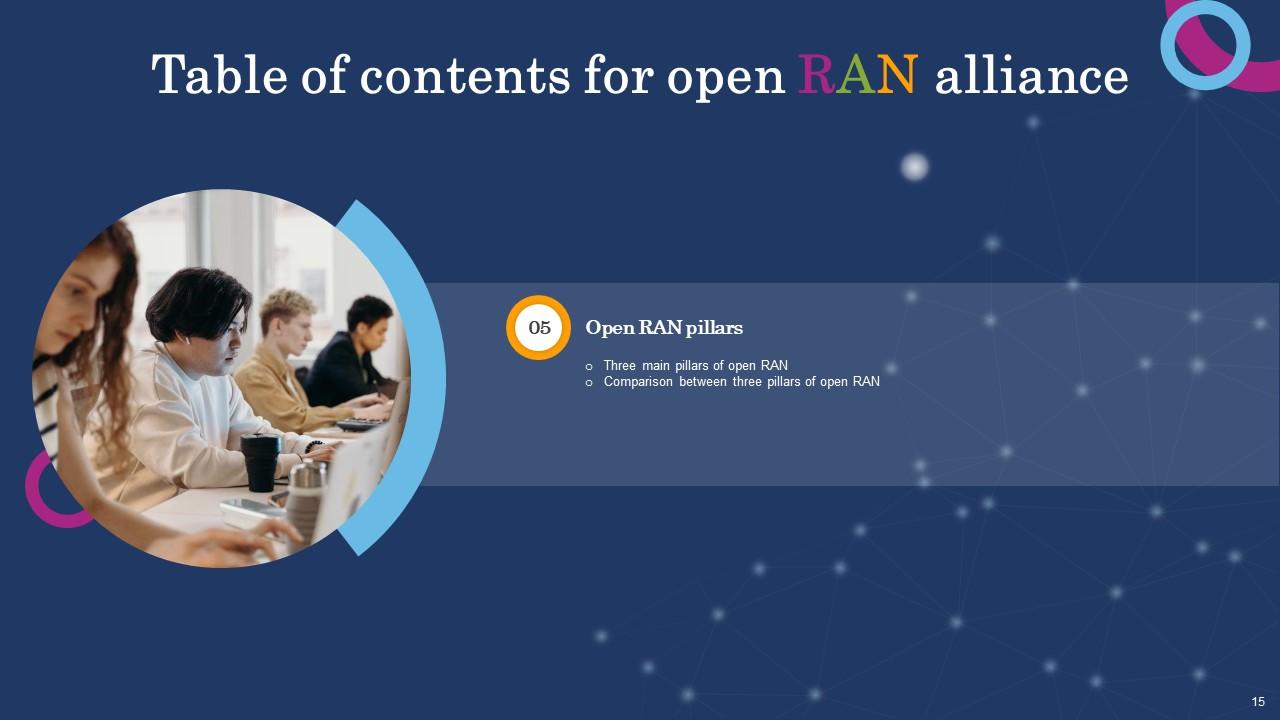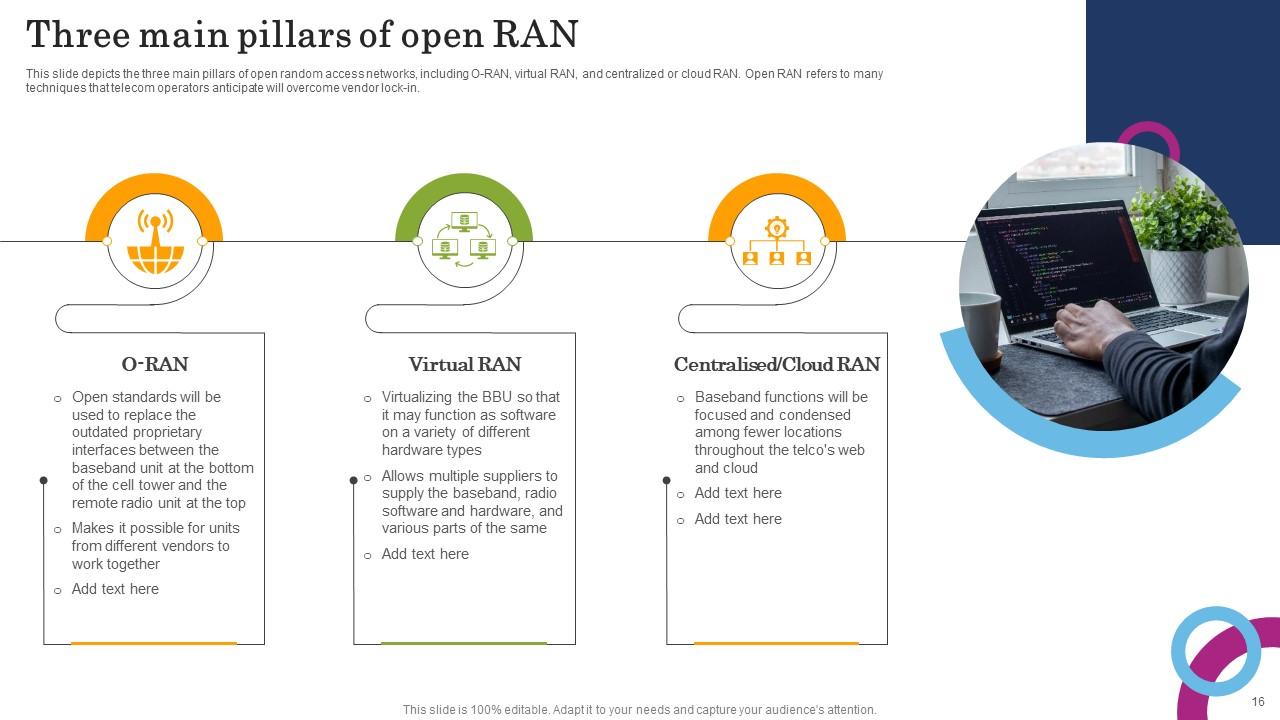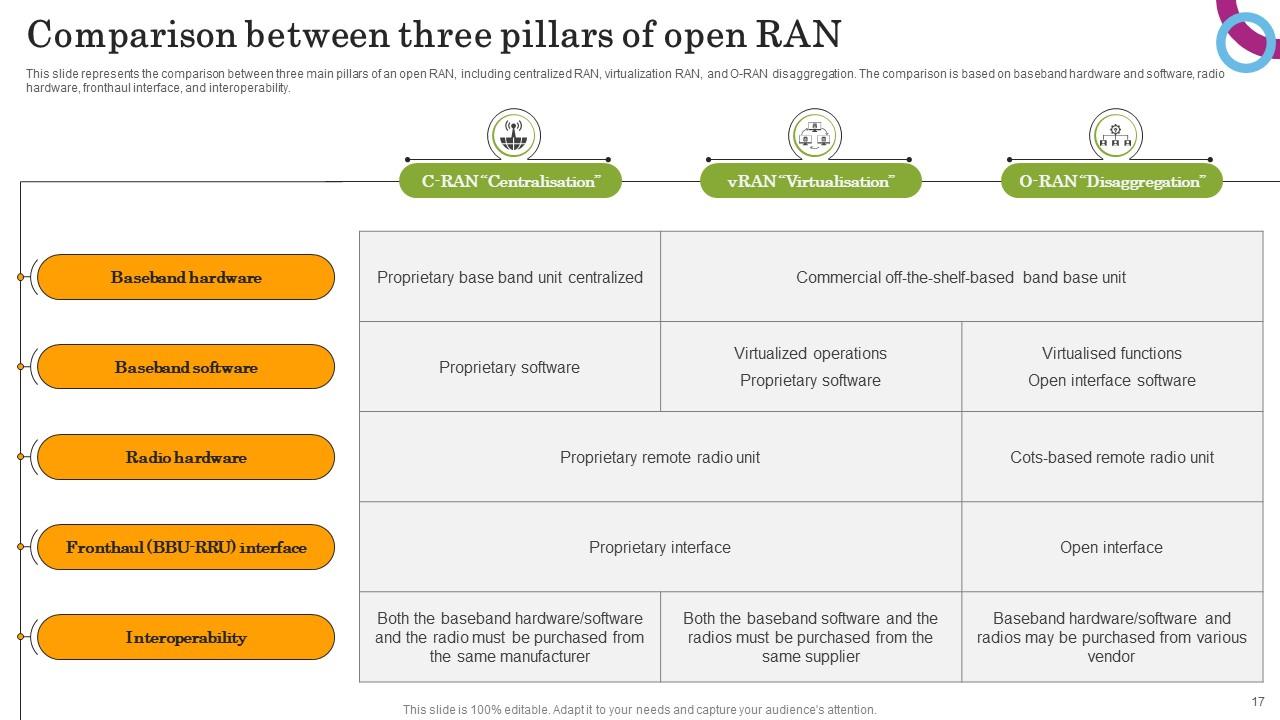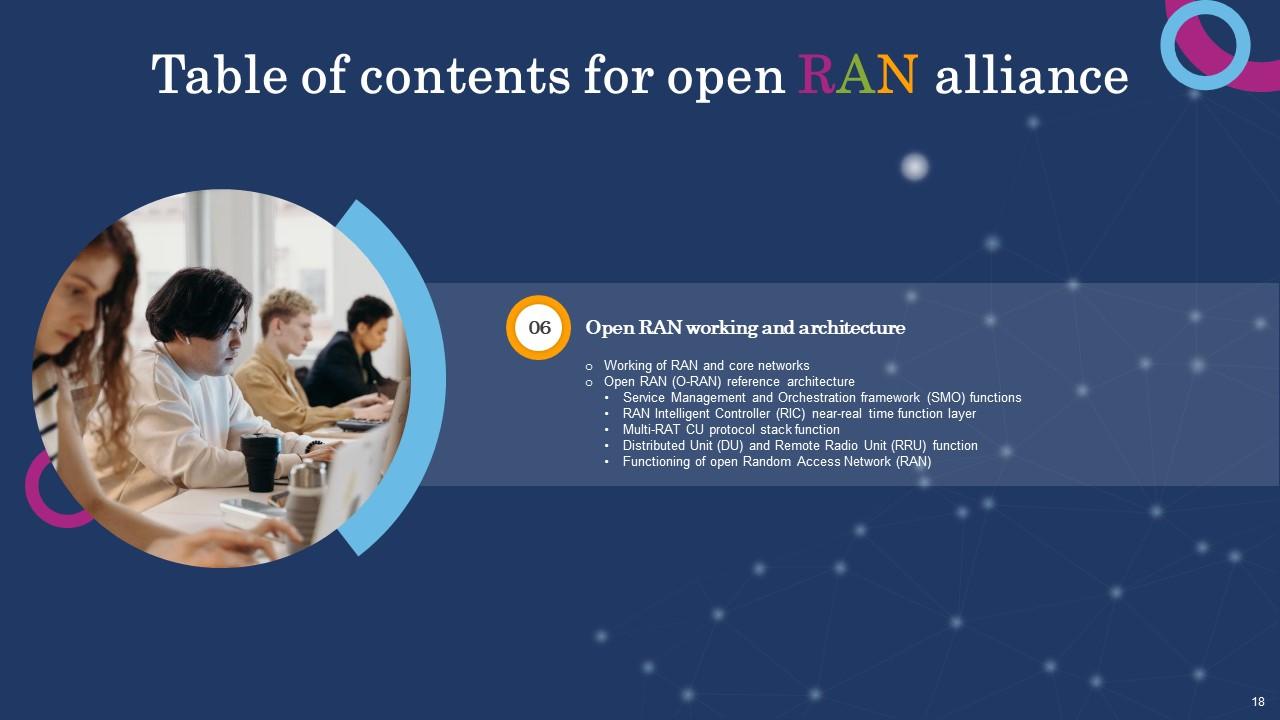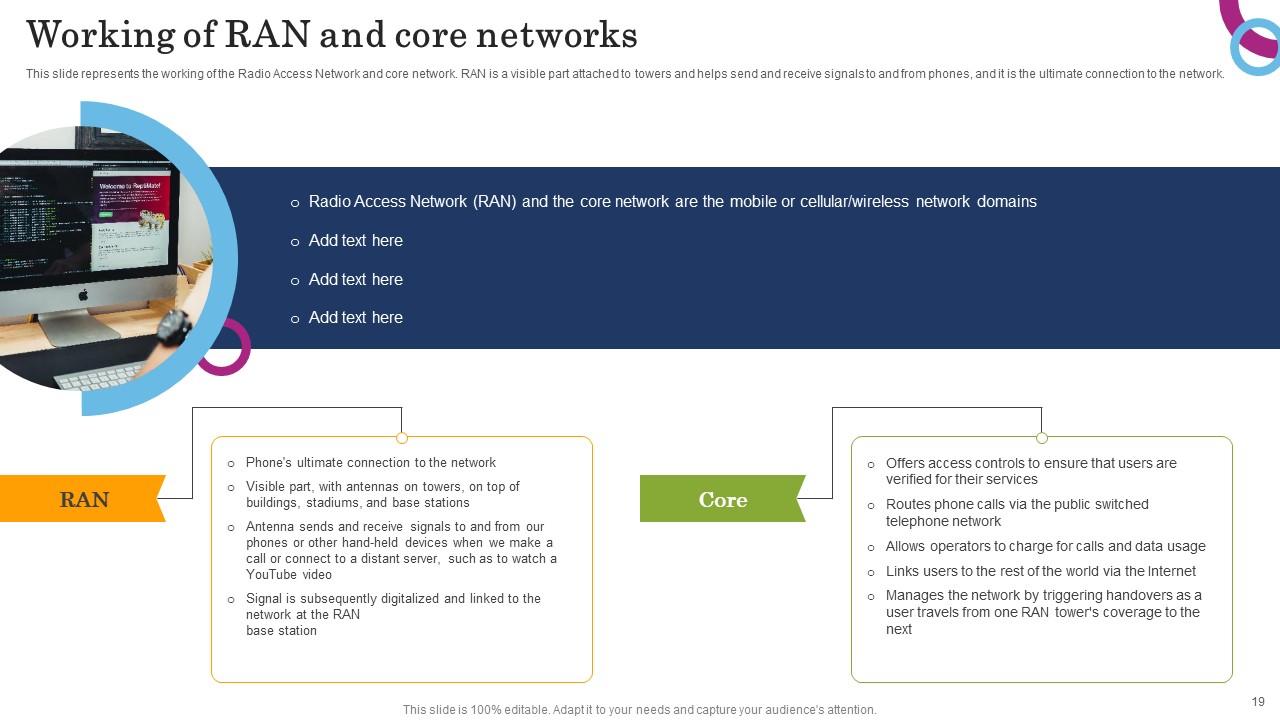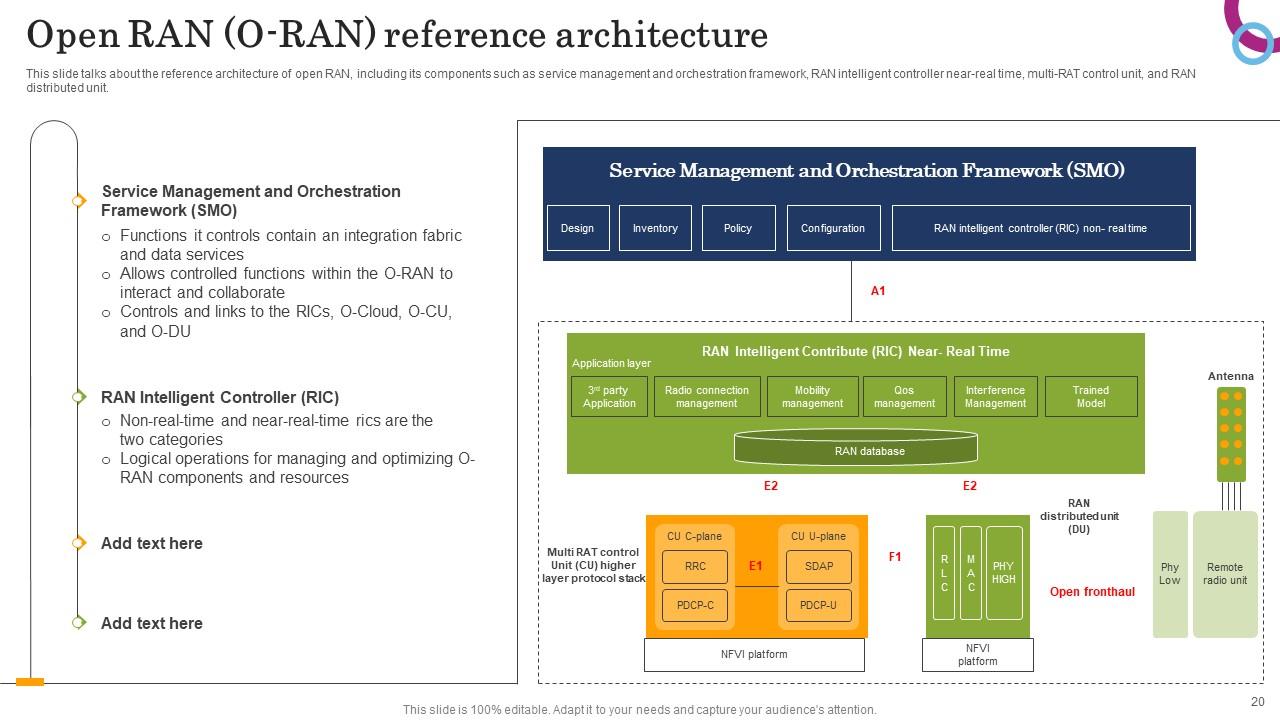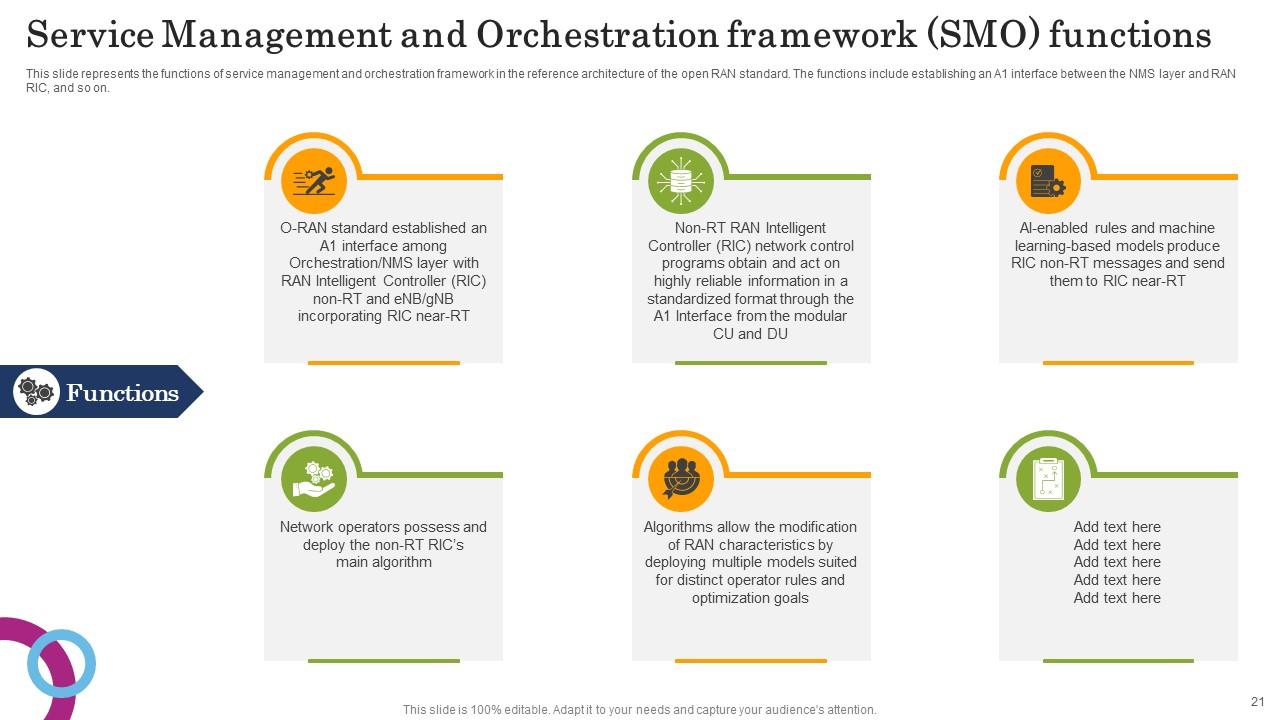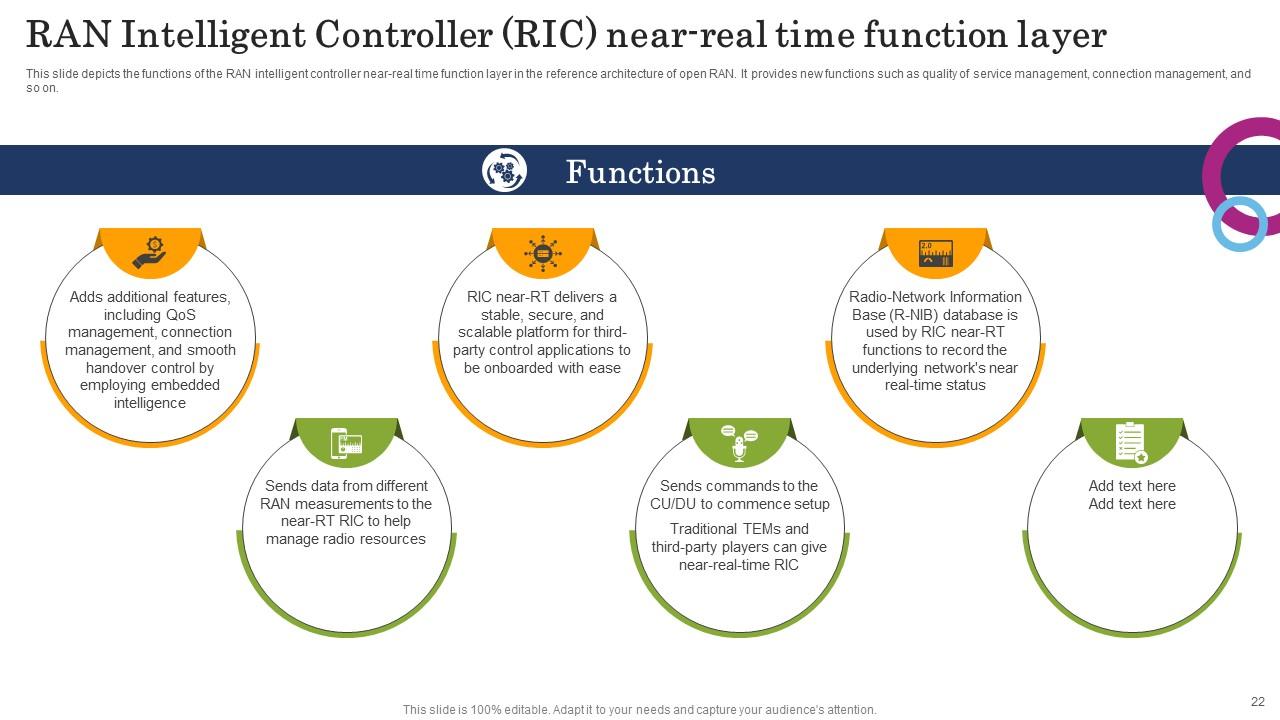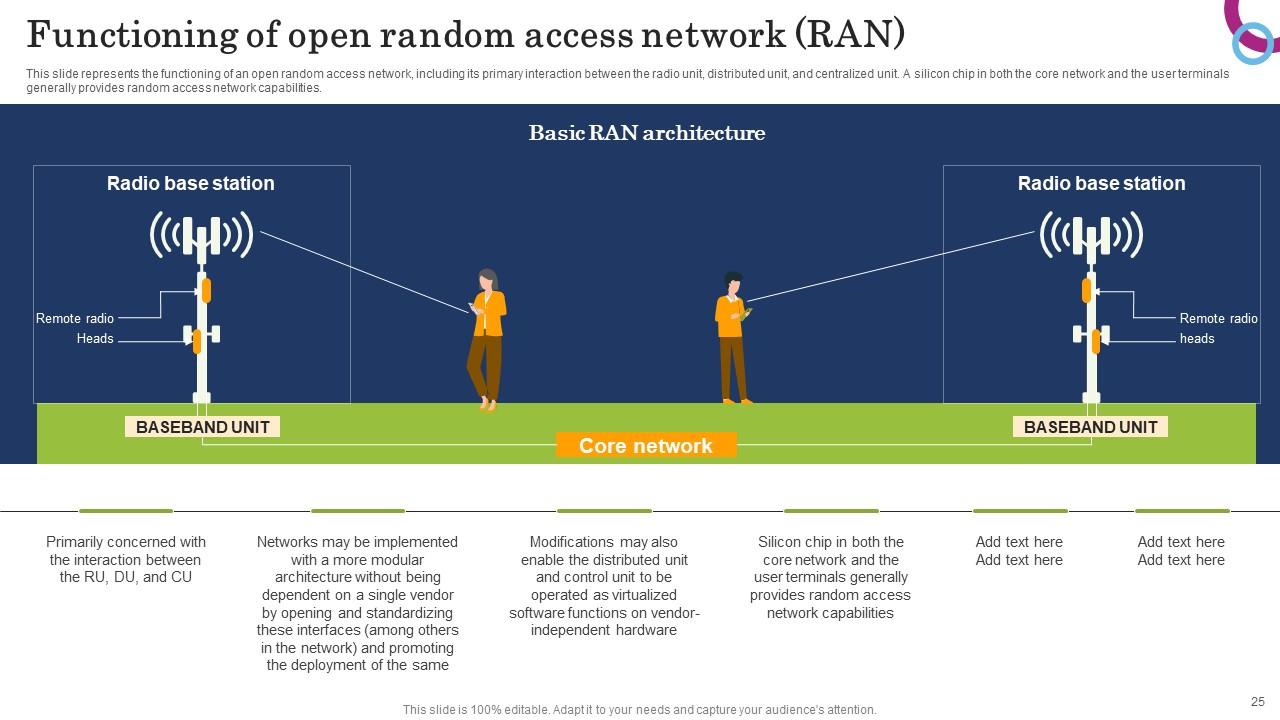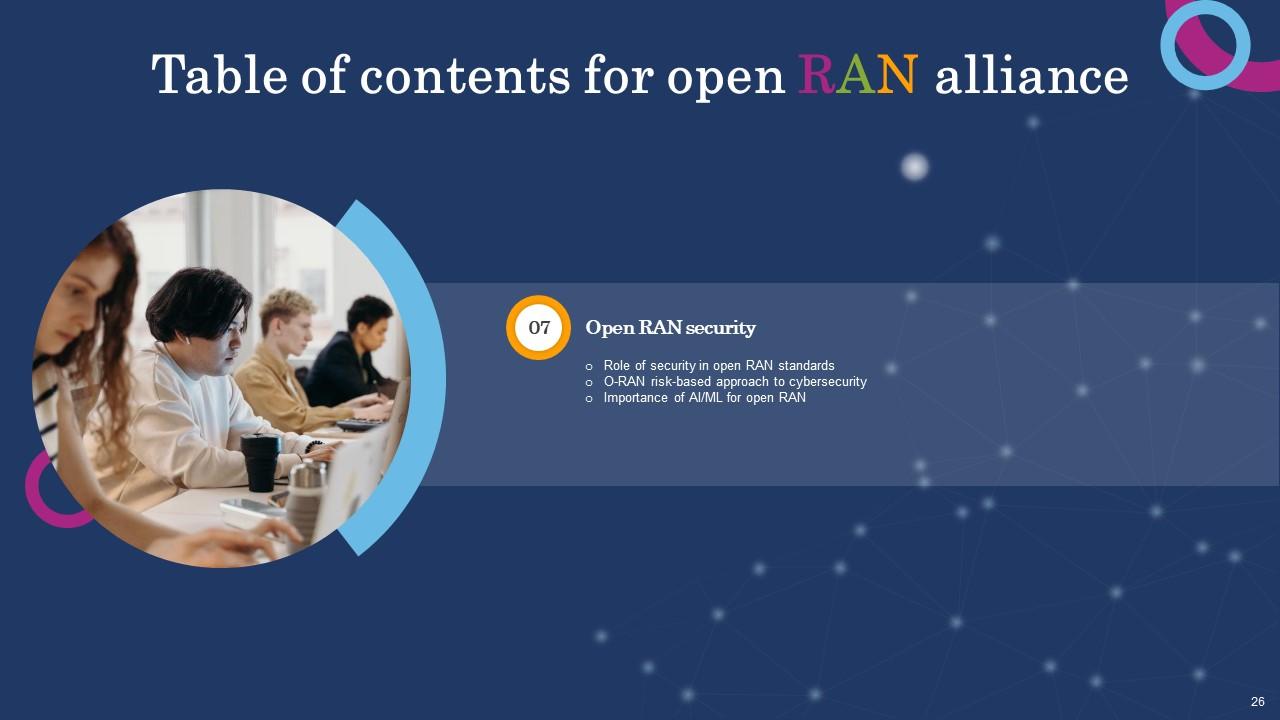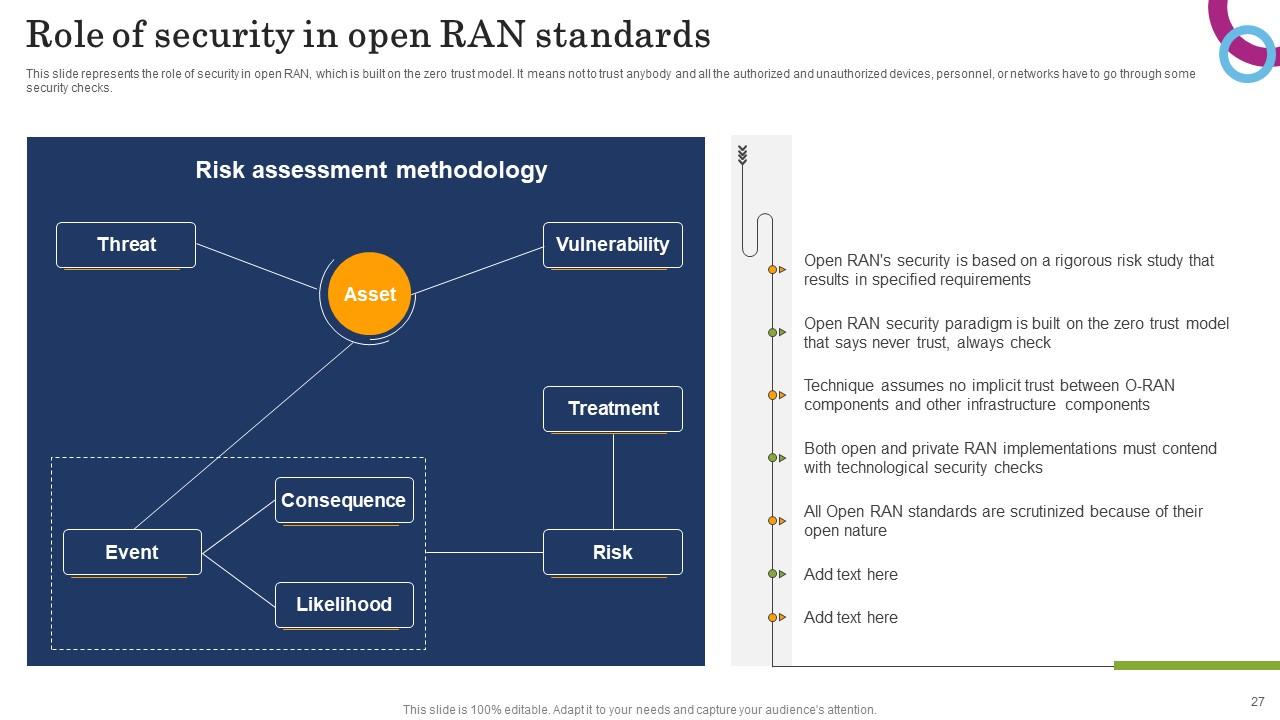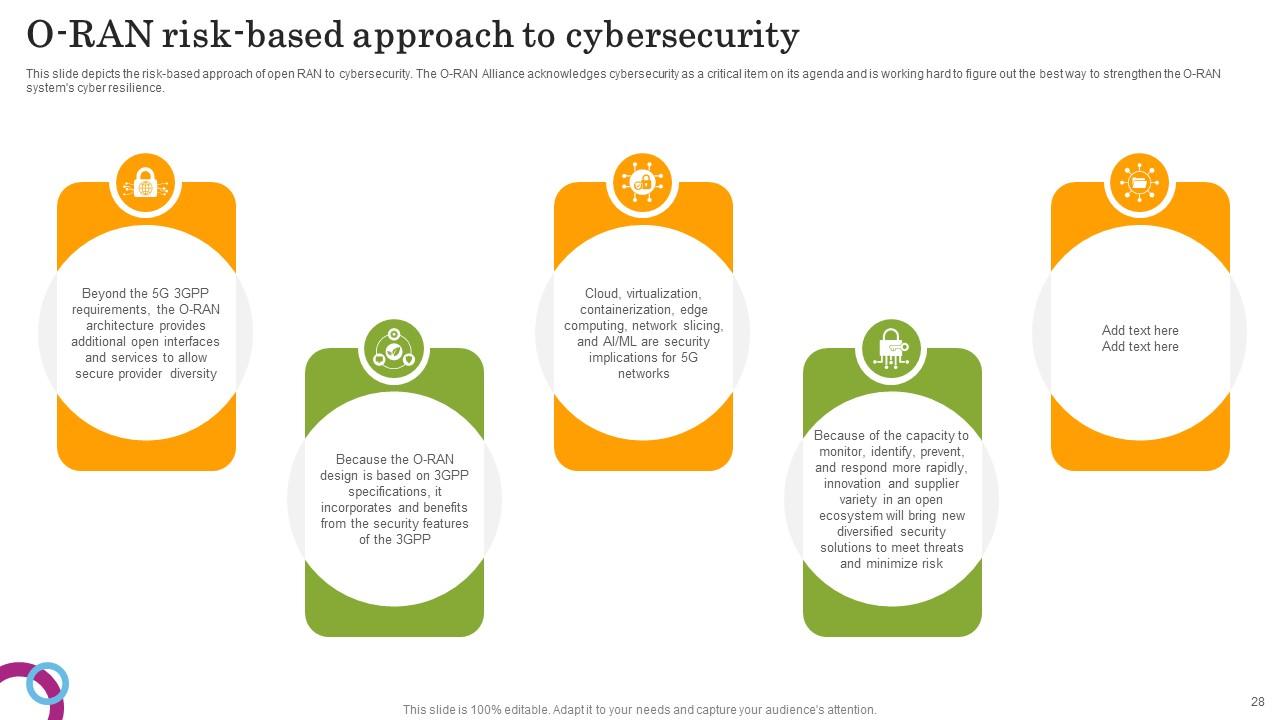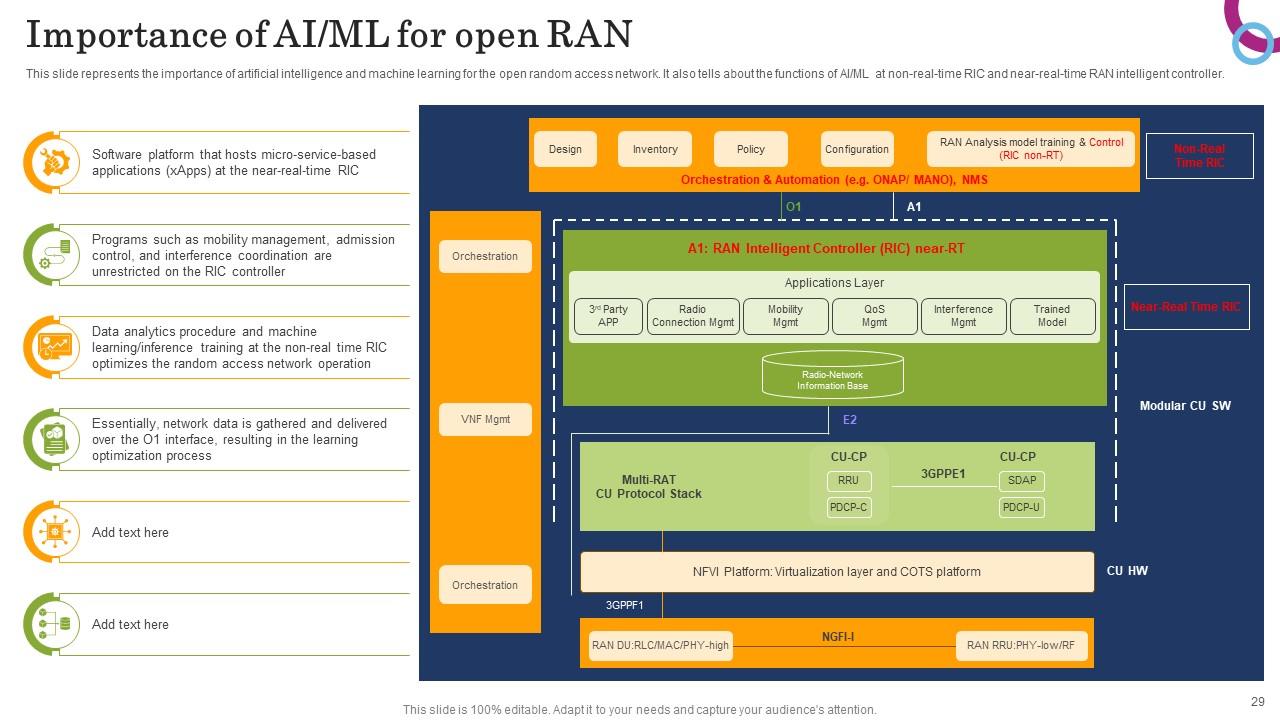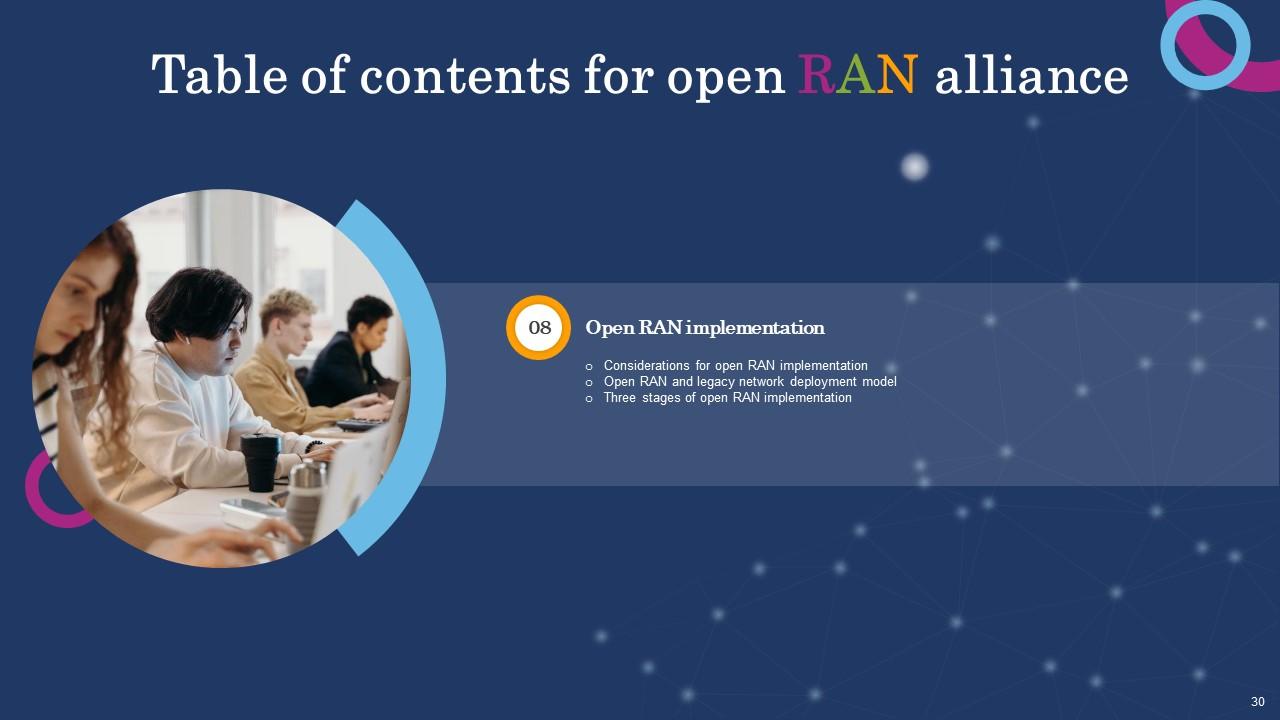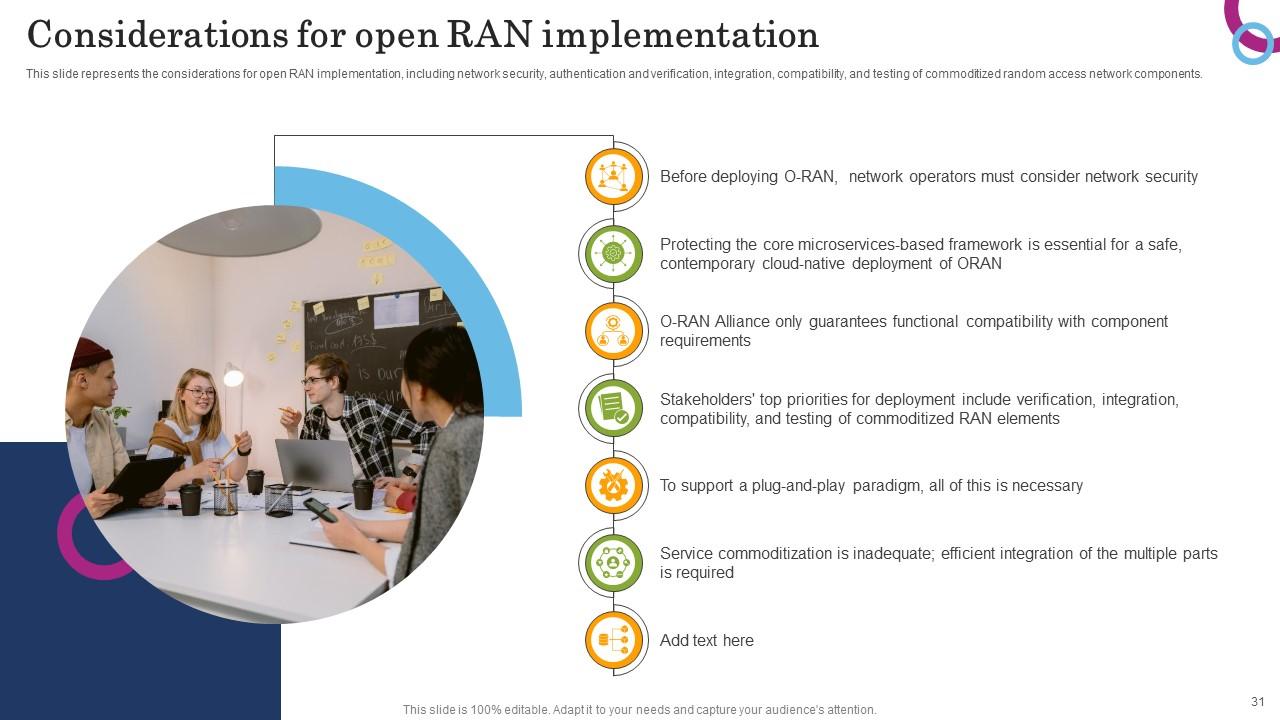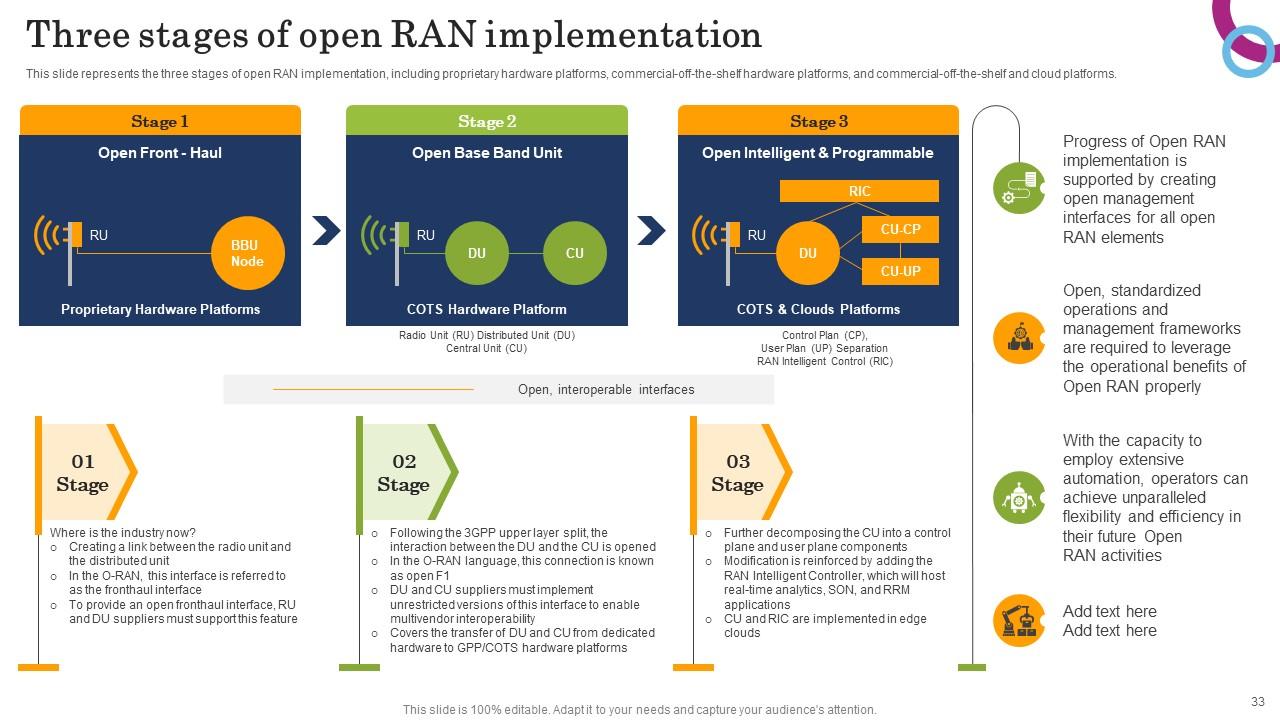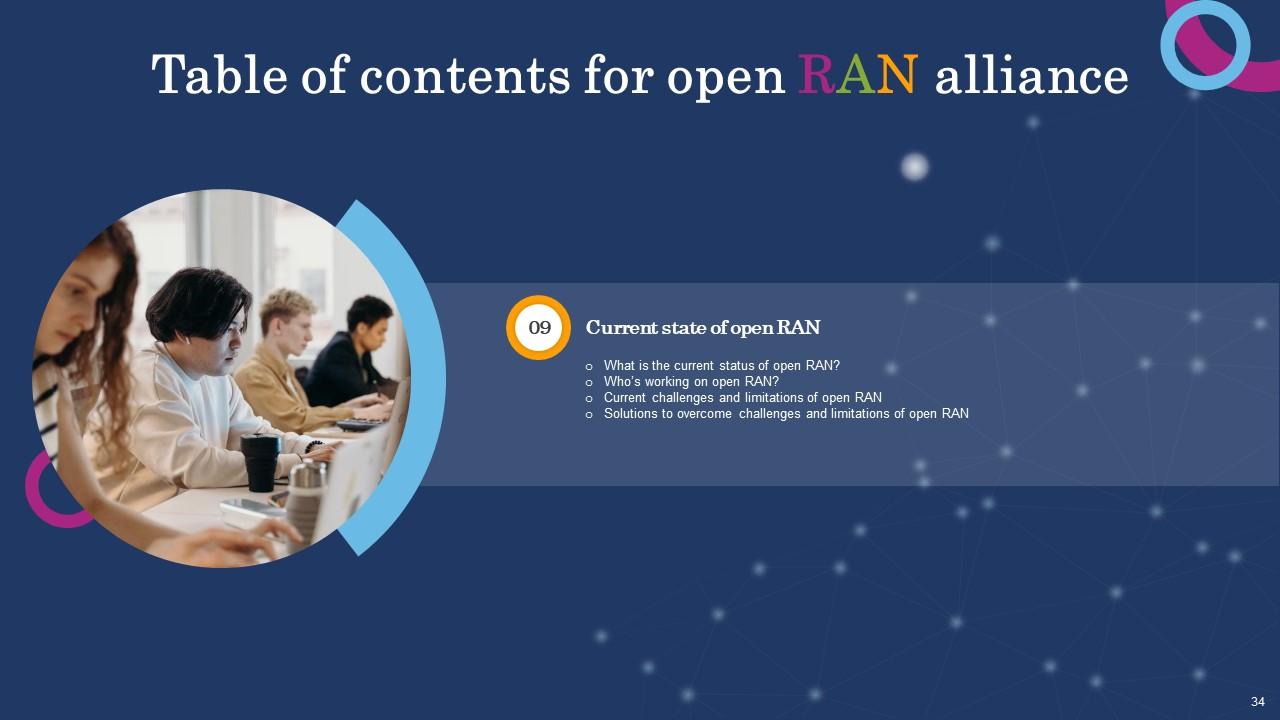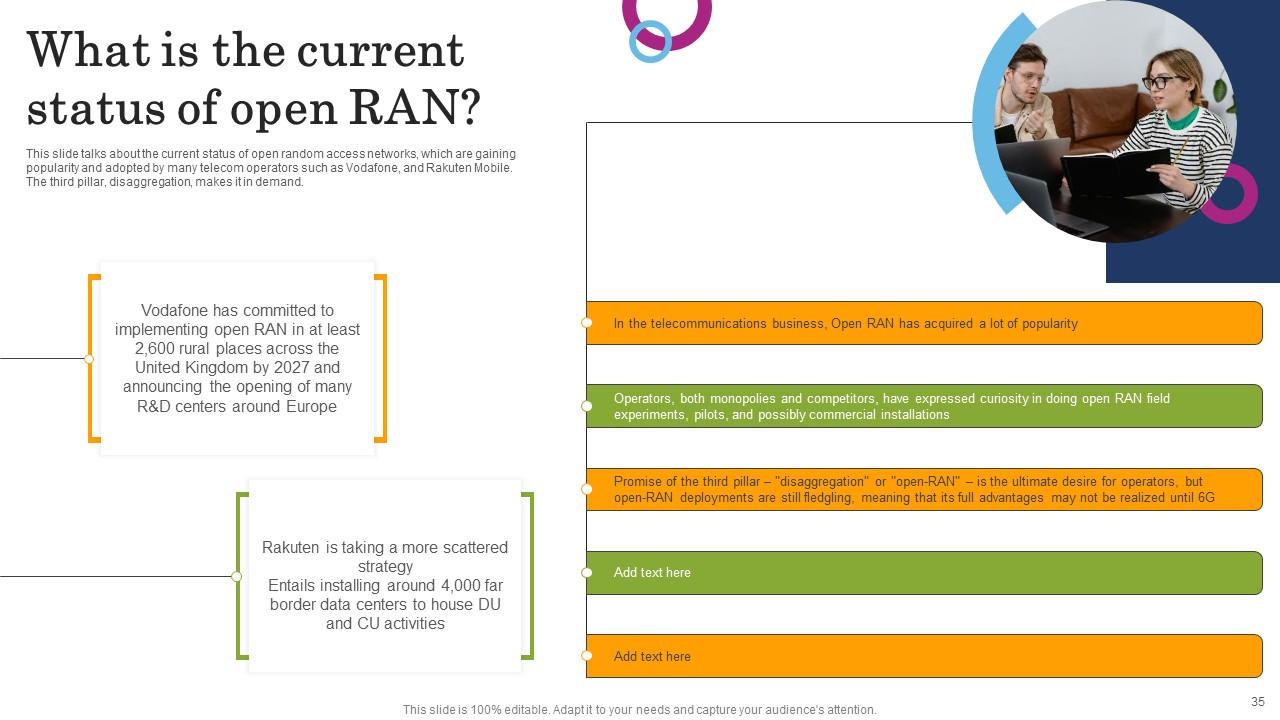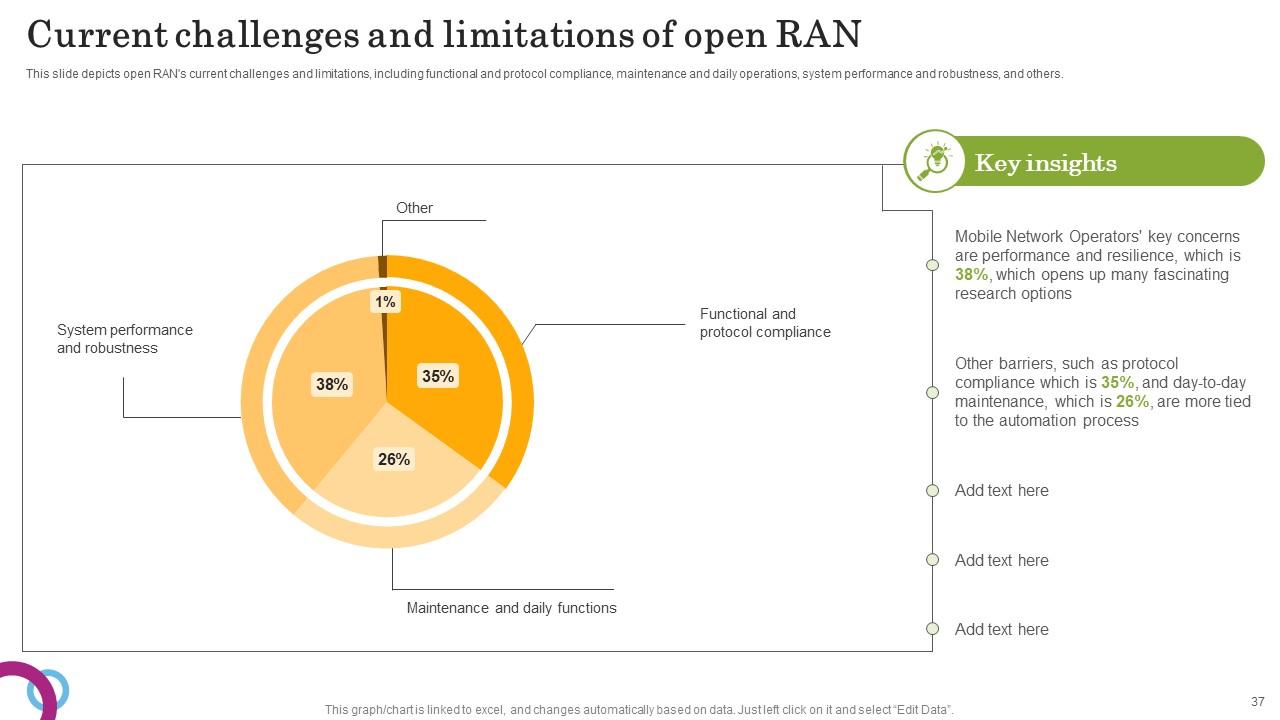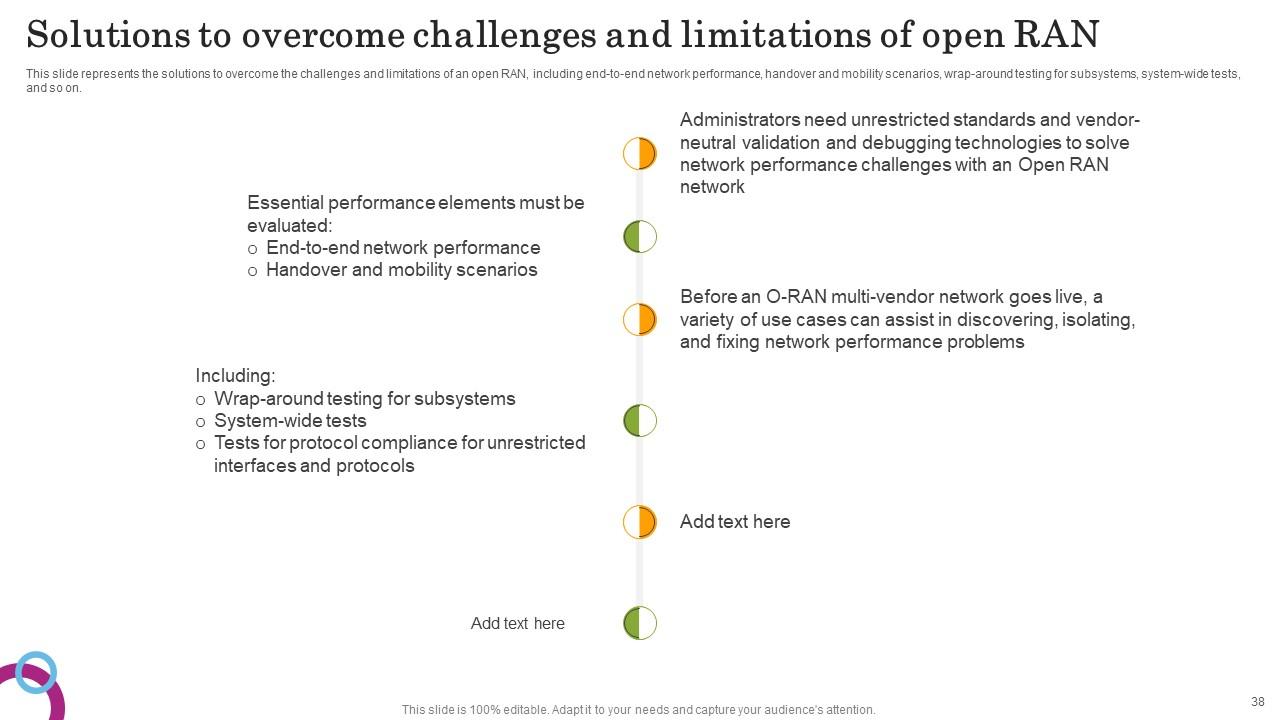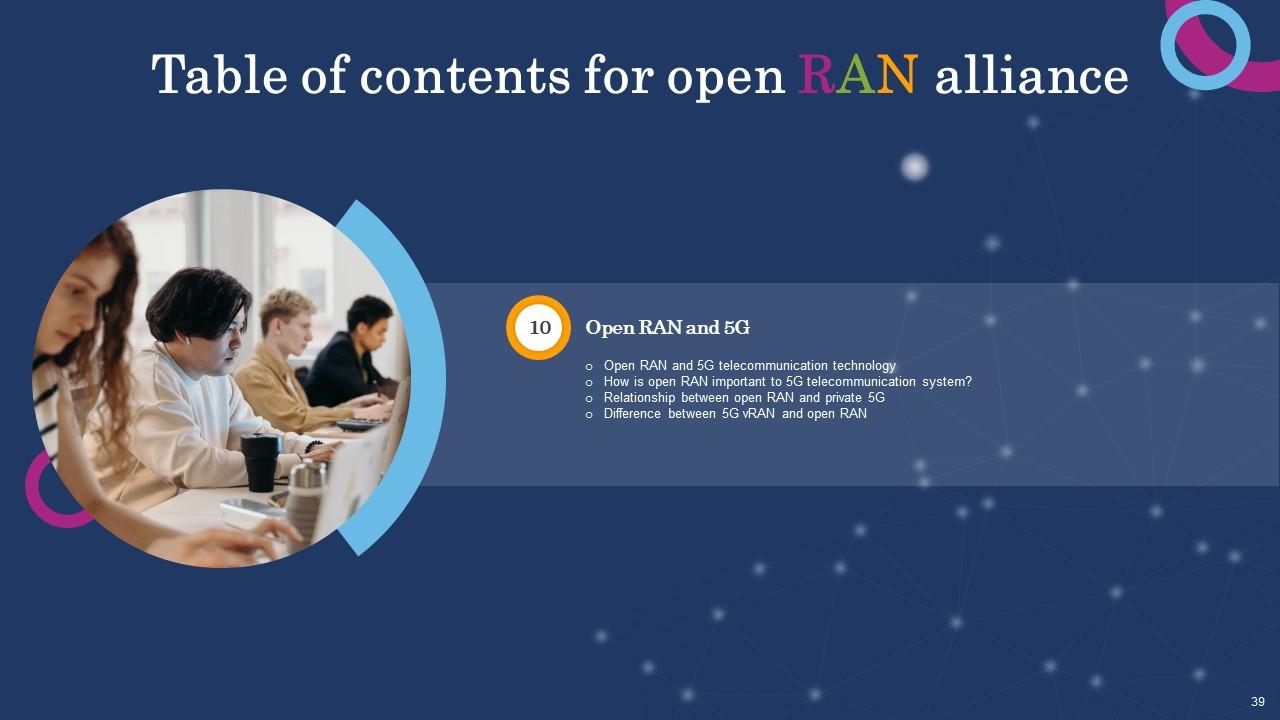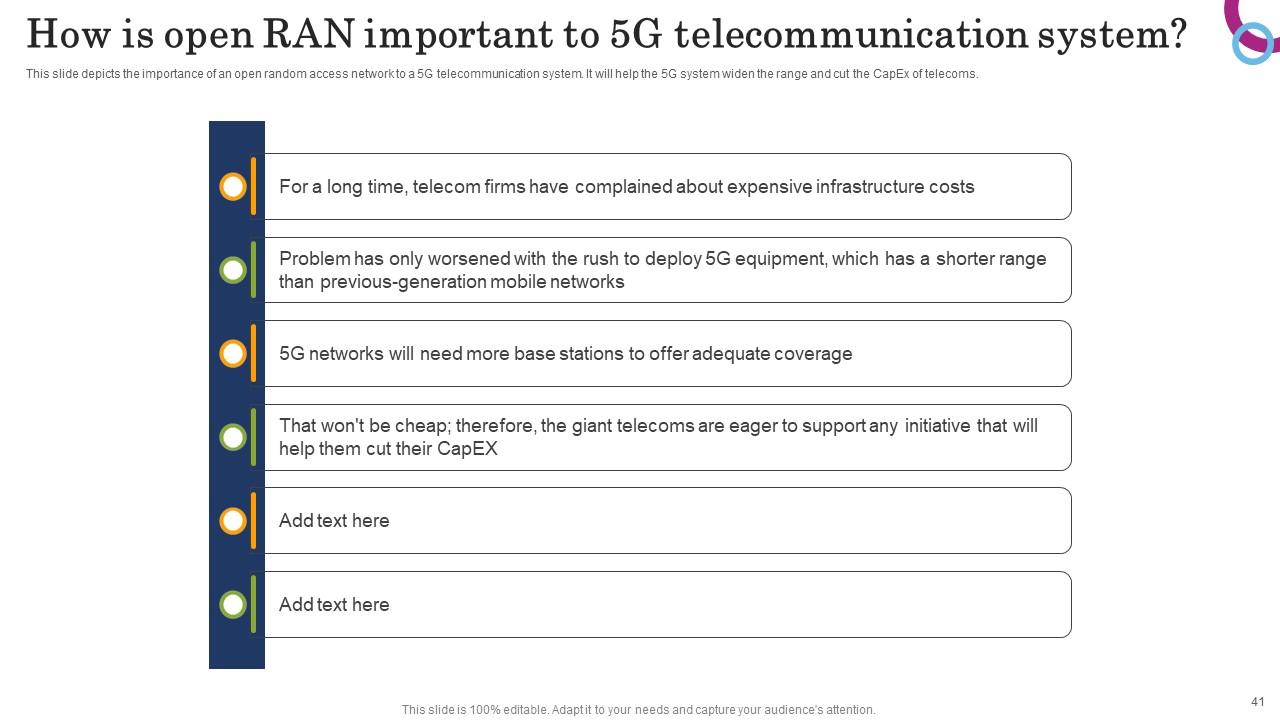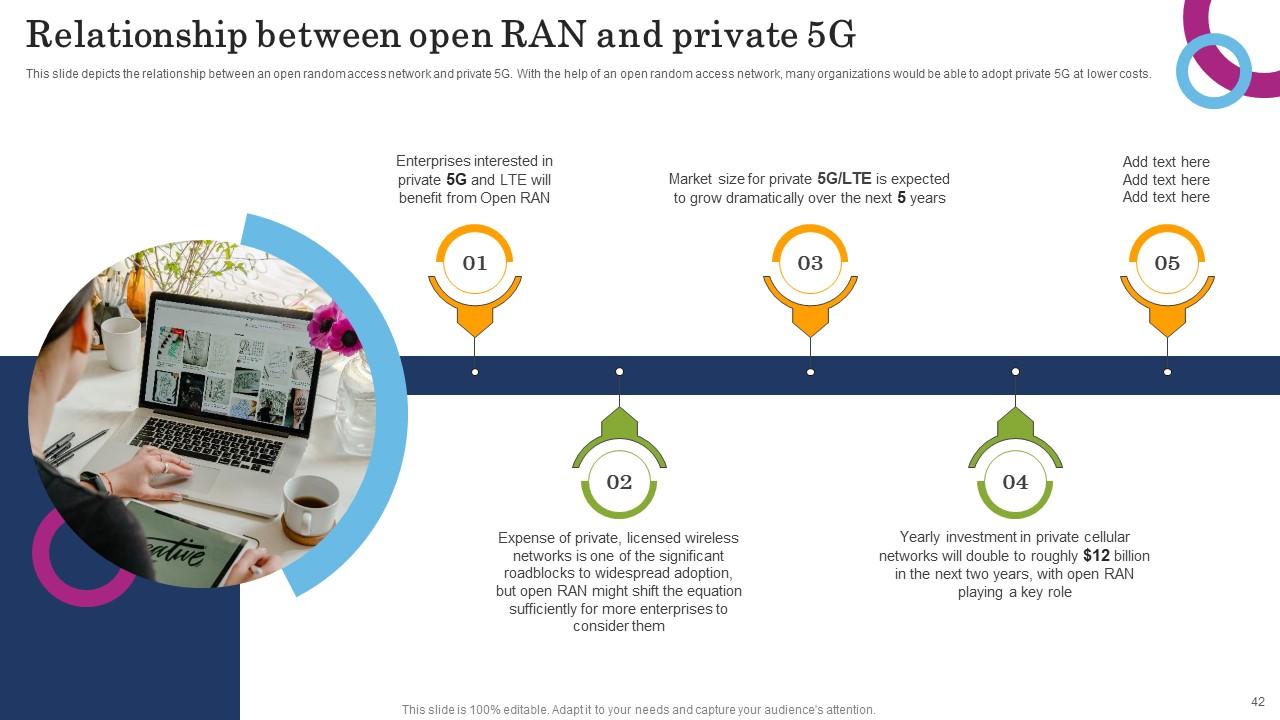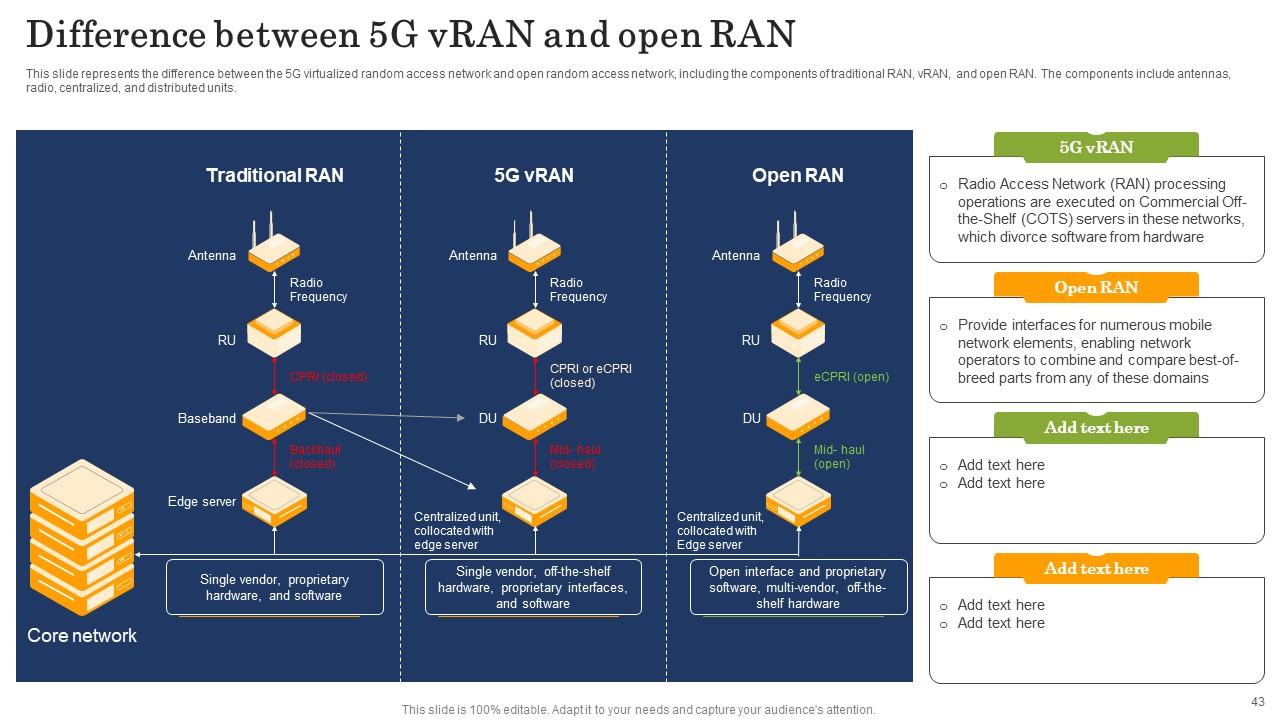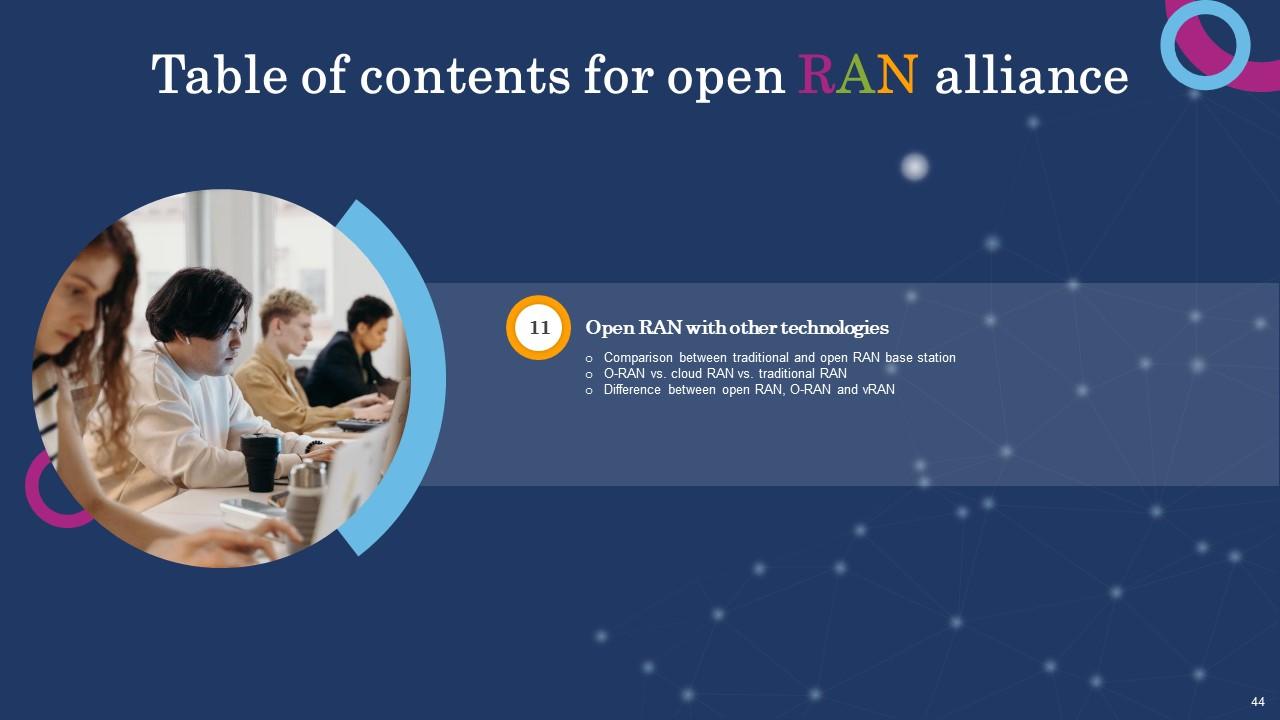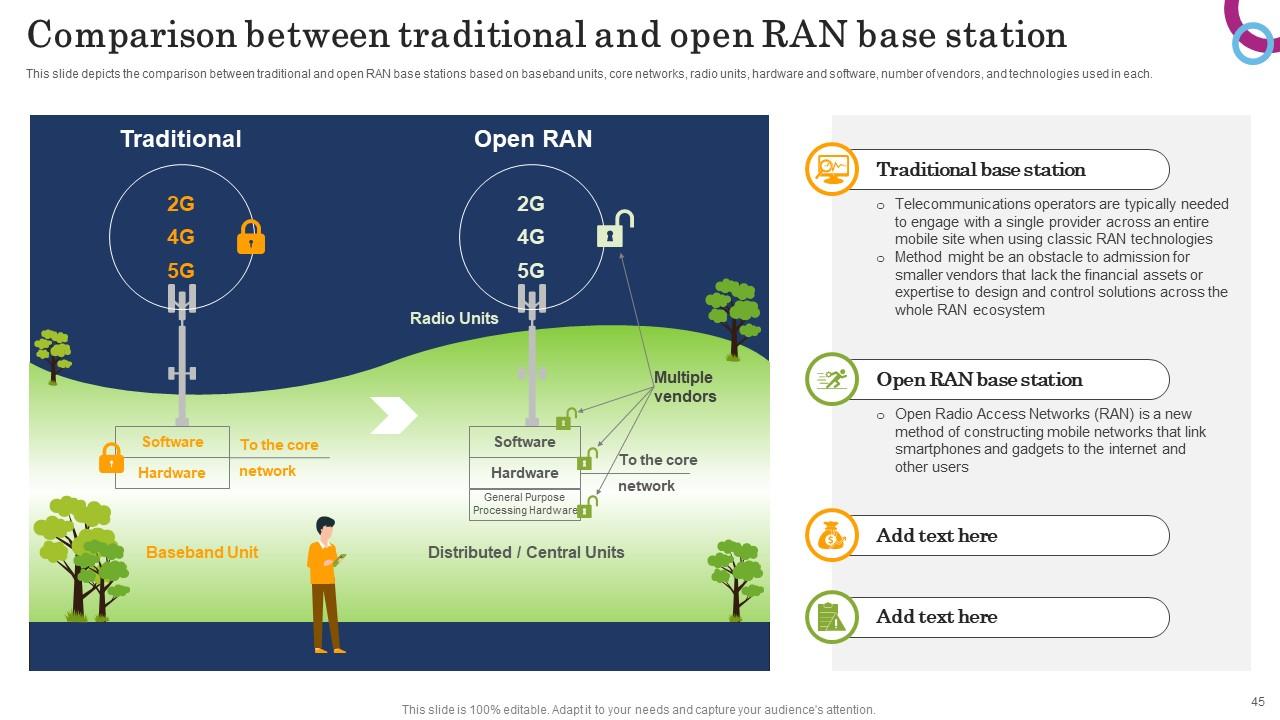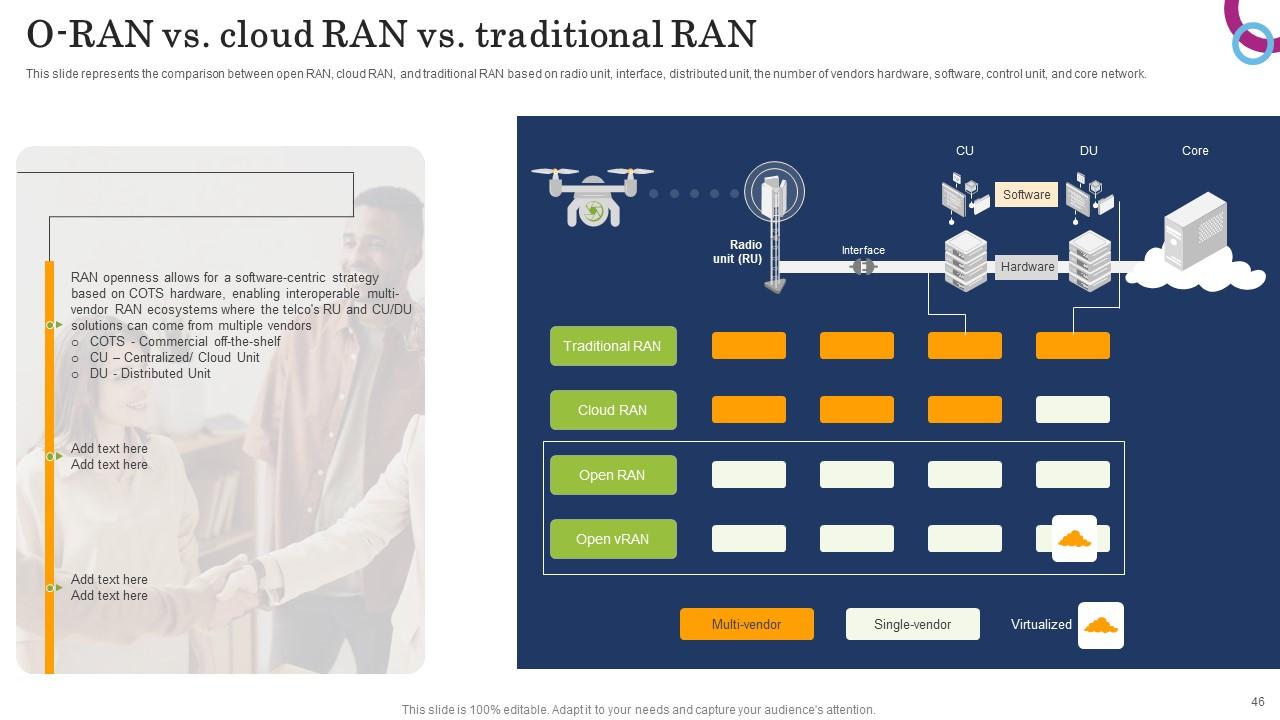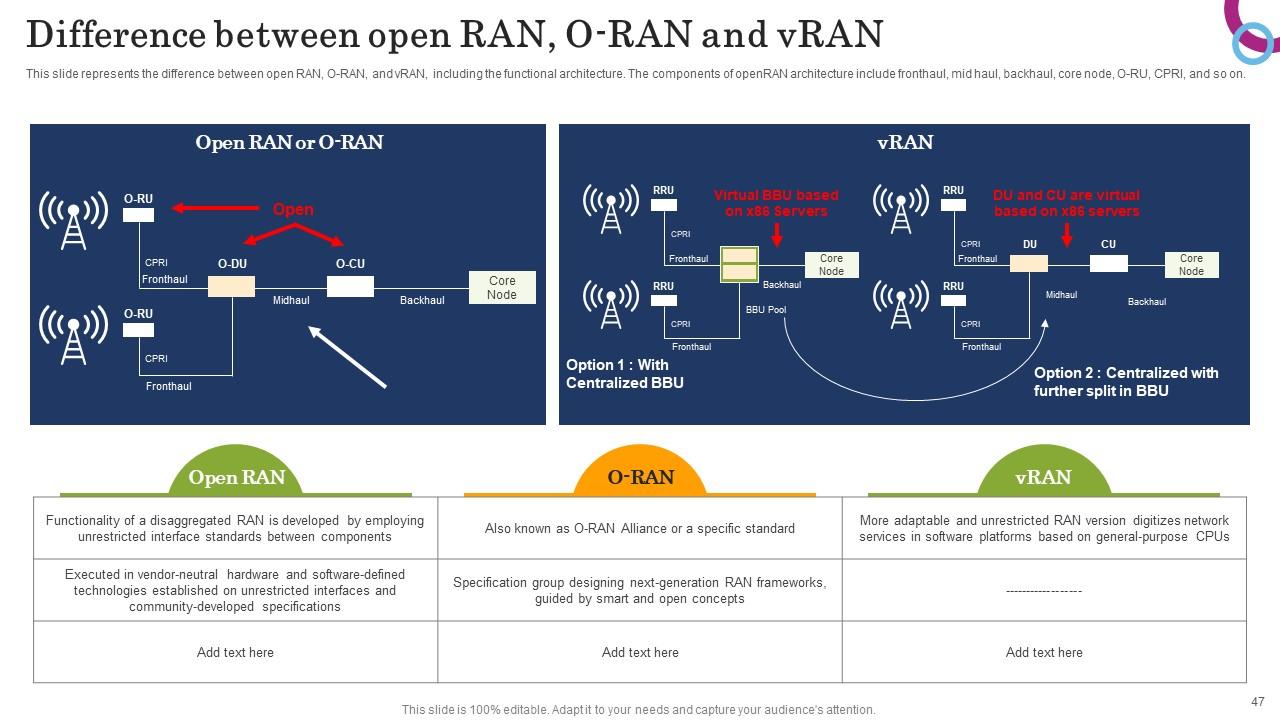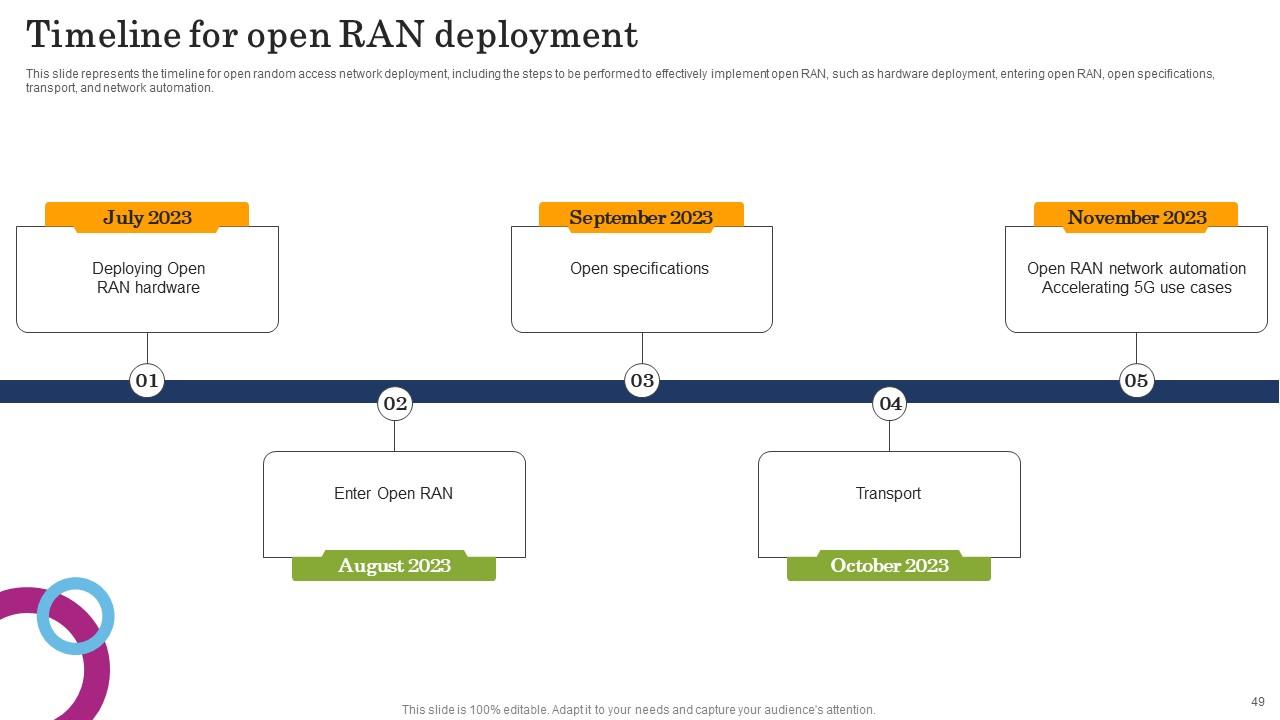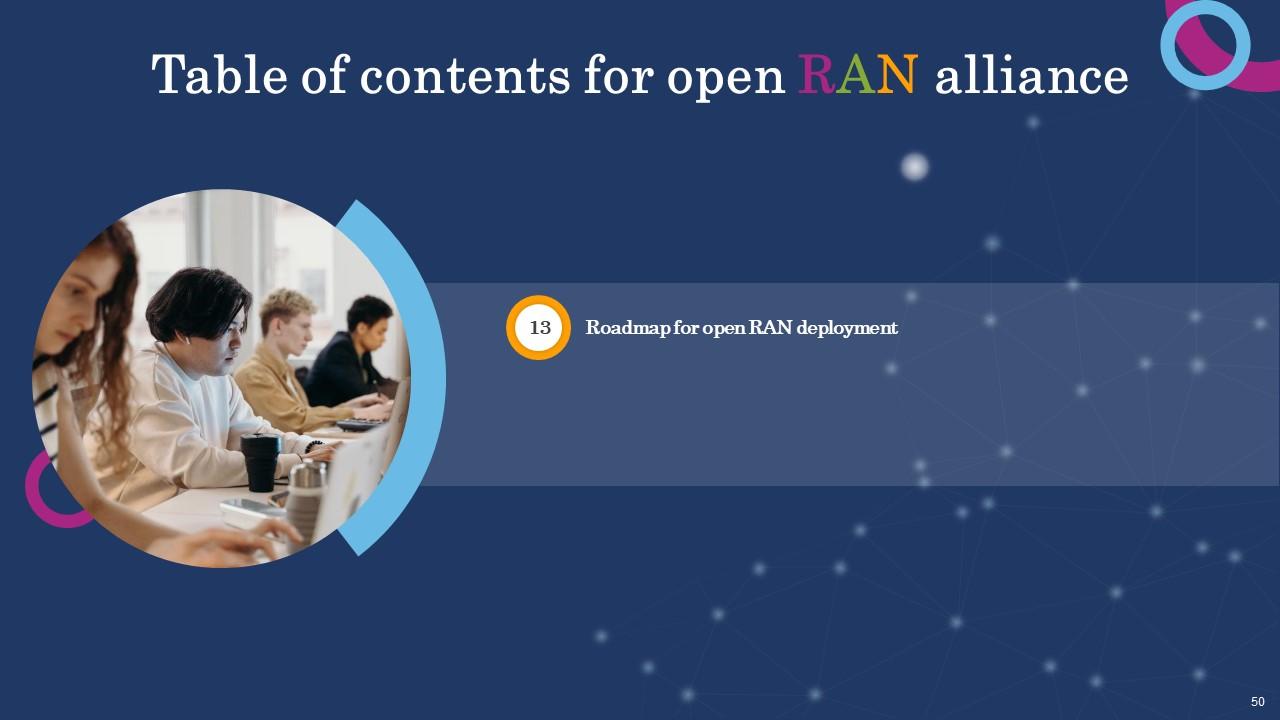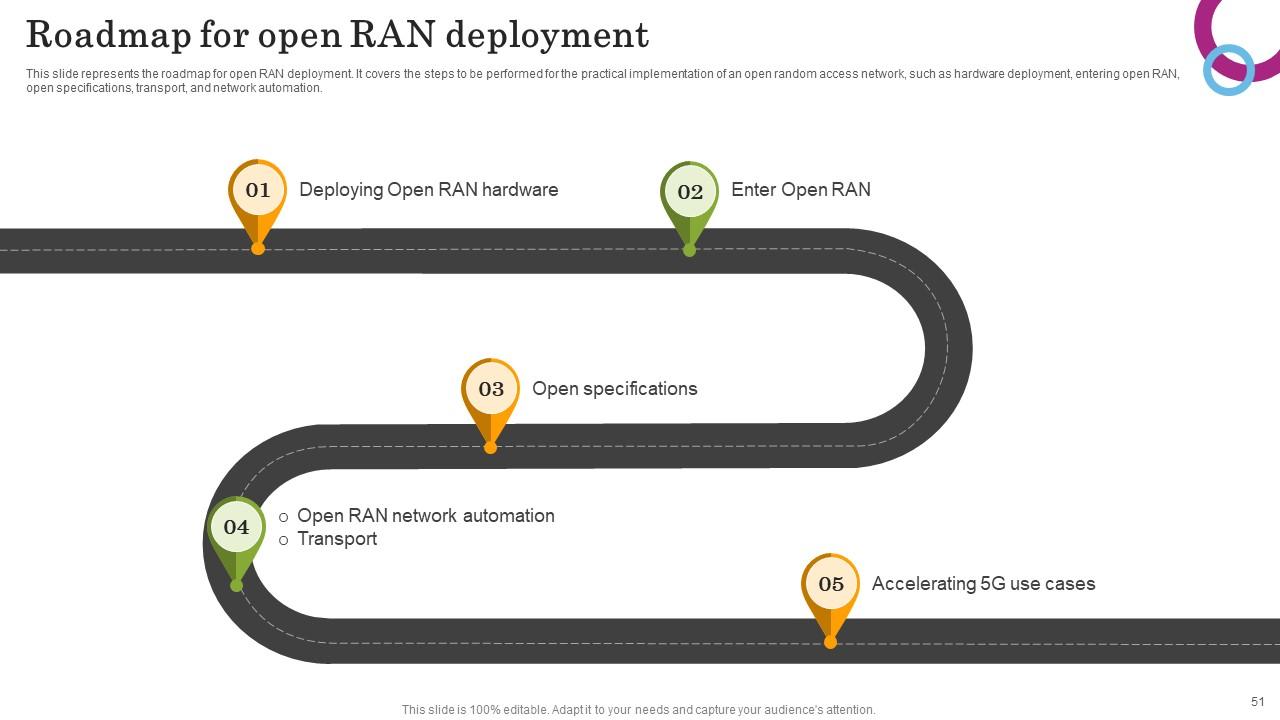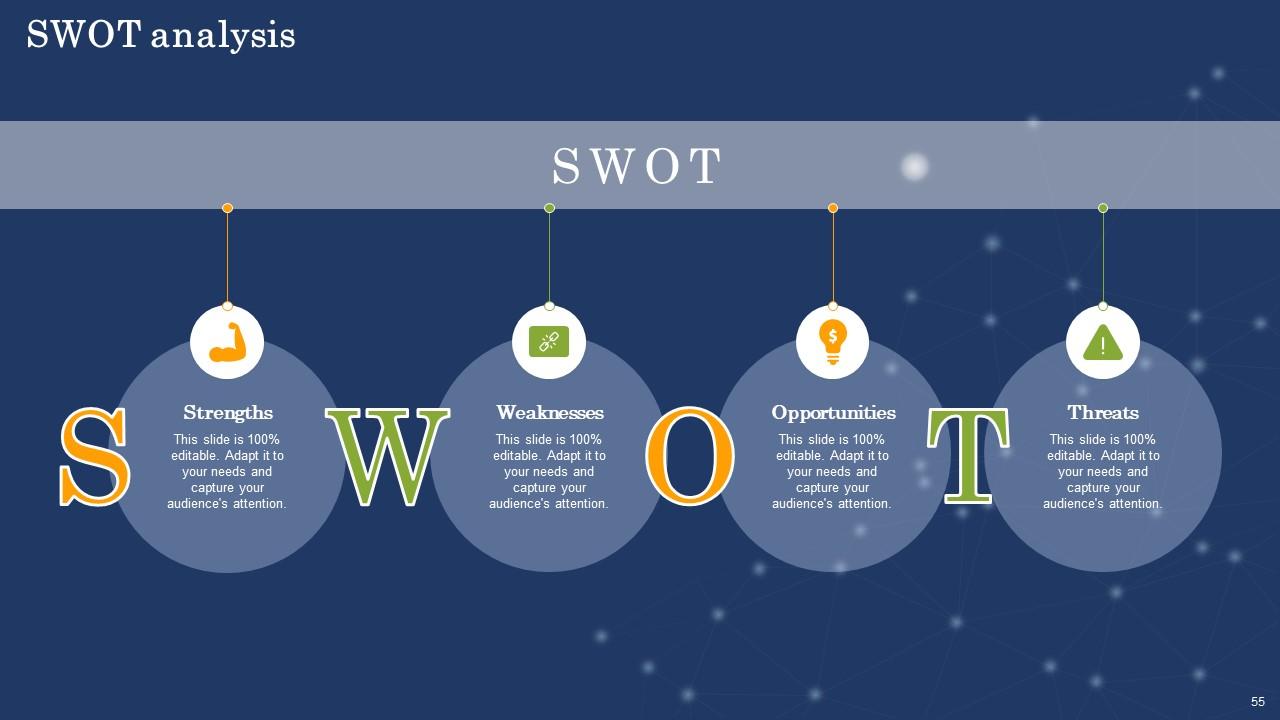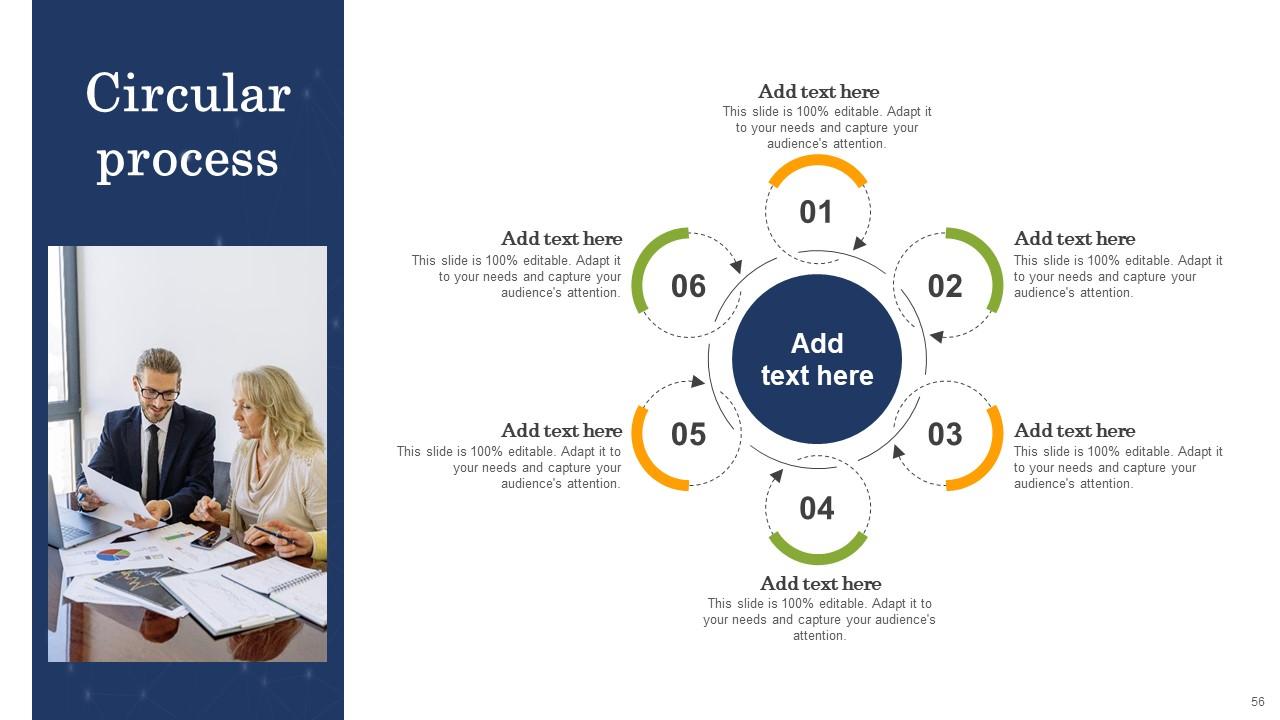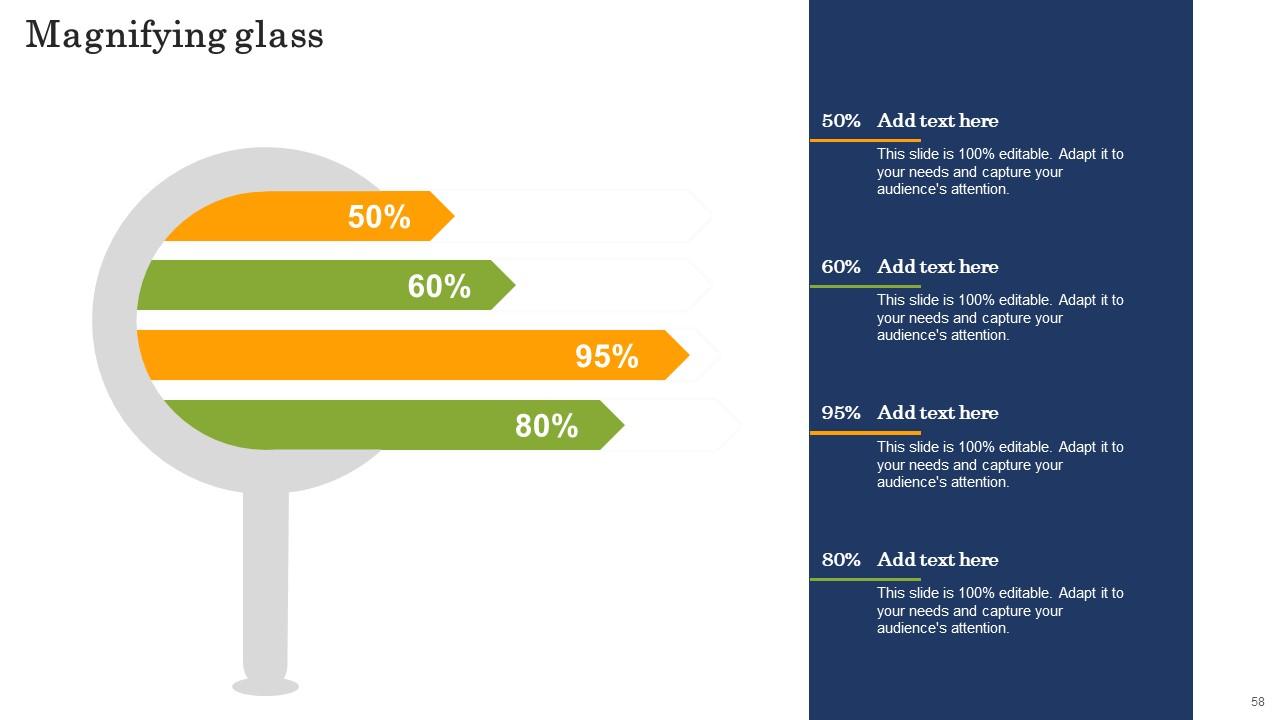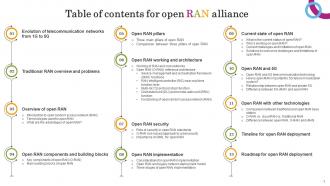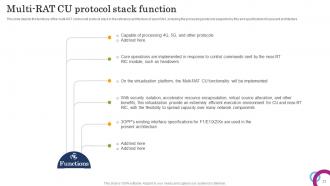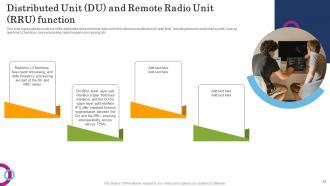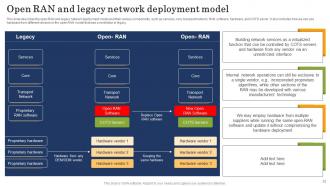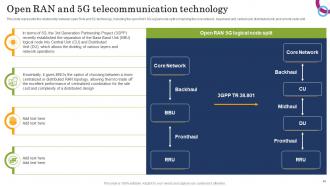Open RAN Alliance Powerpoint Presentation Slides
This Open RAN Alliance PowerPoint presentation offers an overview of the evolution of telecommunication networks, with a specific focus on the transition from 1G to 5G. The deck introduces the concept of Open RAN, including relevant terminology and its benefits. Furthermore, it explores the components and building blocks of Open RAN, highlighting its three main pillars and comparing them. The Open RAN technology PPT covers the operational aspects of Open RAN, including the reference architecture, functions, and framework, along with various aspects of Open RAN. In addition, the presentation addresses the importance of security in Open RAN standards, the O-RAN risk-based approach to cybersecurity, and the role of artificial intelligence and machine learning. The template explores the current status, organizations involved, challenges, limitations, and the relationship between Open RAN technology and Open RAN 5G. This template is 100 percent editable and compatible with Google Slides for easy customization.
This Open RAN Alliance PowerPoint presentation offers an overview of the evolution of telecommunication networks, with a sp..
- Google Slides is a new FREE Presentation software from Google.
- All our content is 100% compatible with Google Slides.
- Just download our designs, and upload them to Google Slides and they will work automatically.
- Amaze your audience with SlideTeam and Google Slides.
-
Want Changes to This PPT Slide? Check out our Presentation Design Services
- WideScreen Aspect ratio is becoming a very popular format. When you download this product, the downloaded ZIP will contain this product in both standard and widescreen format.
-

- Some older products that we have may only be in standard format, but they can easily be converted to widescreen.
- To do this, please open the SlideTeam product in Powerpoint, and go to
- Design ( On the top bar) -> Page Setup -> and select "On-screen Show (16:9)” in the drop down for "Slides Sized for".
- The slide or theme will change to widescreen, and all graphics will adjust automatically. You can similarly convert our content to any other desired screen aspect ratio.
Compatible With Google Slides

Get This In WideScreen
You must be logged in to download this presentation.
PowerPoint presentation slides
Deliver this complete deck to your team members and other collaborators. Encompassed with stylized slides presenting various concepts, this Open RAN Alliance Powerpoint Presentation Slides is the best tool you can utilize. Personalize its content and graphics to make it unique and thought-provoking. All the sixty slides are editable and modifiable, so feel free to adjust them to your business setting. The font, color, and other components also come in an editable format making this PPT design the best choice for your next presentation. So, download now.
Content of this Powerpoint Presentation
Slide 1: This slide displays the title Open RAN Alliance.
Slide 2: This slide displays the title Agenda for open RAN.
Slide 3: This slide exhibit table of content.
Slide 4: This slide exhibit table of content- Evolution of telecommunication networks from 1G to 5G
Slide 5: This slide depicts the evolution of telecommunication networks from 1G to 5G from 1979 to 2020.
Slide 6: This slide exhibit table of content- Traditional RAN overview and problems.
Slide 7: This slide represents the overview of the traditional RAN system, including the problems associated with it.
Slide 8: This slide exhibit table of content- Overview of open RAN.
Slide 9: This slide represents the introduction to open RAN standards in telecommunication systems.
Slide 10: This slide depicts the terminologies used for O-RAN in an open random access network.
Slide 11: This slide represents the advantages of open RAN standards for businesses.
Slide 12: This slide exhibit table of content- Open RAN components and building blocks.
Slide 13: This slide represents the key components of an open random access network.
Slide 14: This slide describes the main building blocks of open RAN, and it includes a radio unit, distributed unit, and centralized unit.
Slide 15: This slide exhibit table of content- Open RAN pillars
Slide 16: This slide depicts the three main pillars of open random access networks, including O-RAN, virtual RAN, and centralized or cloud RAN.
Slide 17: This slide represents the comparison between three main pillars of an open RAN, including centralized RAN, virtualization RAN, and O-RAN disaggregation.
Slide 18: This slide exhibit table of content- Working of RAN and core networks
Slide 19: This slide represents the working of the Radio Access Network and core network.
Slide 20: This slide talks about the reference architecture of open RAN.
Slide 21: This slide represents the functions of service management and orchestration framework in the reference architecture of the open RAN standard.
Slide 22: This slide depicts the functions of the RAN intelligent controller near-real time function layer in the reference architecture of open RAN.
Slide 23: This slide depicts the functions of the multi-RAT control unit protocol stack in the reference architecture of open RAN.
Slide 24: This slide represents the functions of the distributed unit and remote radio unit in the reference architecture of open RAN.
Slide 25: This slide represents the functioning of an open random access network.
Slide 26: This slide exhibit table of content- Open RAN security.
Slide 27: This slide represents the role of security in open RAN, which is built on the zero trust model.
Slide 28: This slide depicts the risk-based approach of open RAN to cybersecurity.
Slide 29: This slide represents the importance of artificial intelligence and machine learning for the open random access network.
Slide 30: This slide exhibit table of content- Open RAN implementation.
Slide 31: This slide represents the considerations for open RAN implementation.
Slide 32: This slide describes the open RAN and legacy network deployment model and their various components.
Slide 33: This slide represents the three stages of open RAN implementation.
Slide 34: This slide exhibit table of content- Current state of open RAN.
Slide 35: This slide talks about the current status of open random access networks.
Slide 36: This slide outlines the organizations or groups working on open RAN.
Slide 37: This slide depicts open RAN's current challenges and limitations.
Slide 38: This slide represents the solutions to overcome the challenges and limitations of an open RAN.
Slide 39: This slide exhibit table of content- Open RAN and 5G.
Slide 40: This slide represents the relationship between open RAN and 5G technology.
Slide 41: This slide depicts the importance of an open random access network to a 5G telecommunication system.
Slide 42: This slide depicts the relationship between an open random access network and private 5G.
Slide 43: This slide represents the difference between the 5G virtualized random access network and open random access network.
Slide 44: This slide exhibit table of content- Open RAN with other technologies.
Slide 45: This slide depicts the comparison between traditional and open RAN base stations.
Slide 46: This slide represents the comparison between open RAN, cloud RAN, and traditional RAN based on radio unit, interface, distributed unit, the number of vendors hardware, software, control unit, and core network.
Slide 47: This slide represents the difference between open RAN, O-RAN, and vRAN.
Slide 48: This slide exhibit table of content- Timeline for open RAN deployment.
Slide 49: This slide represents the timeline for open random access network deployment.
Slide 50: This slide exhibit table of content- Roadmap for open RAN deployment.
Slide 51: This slide represents the roadmap for open RAN deployment.
Slide 52: This is the icons slide.
Slide 53: This slide presents title for additional slides.
Slide 54: This slide presents Circular process.
Slide 55: This slide presents Area chart for different products.
Slide 56: This slide display Venn diagram.
Slide 57: This slide shows puzzle for displaying elements of company.
Slide 58: This slide display Magnifying glass.
Slide 59: This slide display Our goal.
Slide 60: This is thank you slide & contains contact details of company like office address, phone no., etc.
Open RAN Alliance Powerpoint Presentation Slides with all 65 slides:
Use our Open RAN Alliance Powerpoint Presentation Slides to effectively help you save your valuable time. They are readymade to fit into any presentation structure.
FAQs
Open RAN refers to an open random access network that follows standardized protocols, enabling network operators to use hardware and software from different vendors. Its advantages for businesses include increased flexibility, reduced vendor lock-in, lower costs, and faster deployment of new services.
Open RAN plays a crucial role in the deployment and optimization of 5G technology. It allows for greater interoperability and flexibility in 5G networks, leading to more cost-effective and efficient implementations. Open RAN is essential in realizing the full potential of 5G and supporting various use cases in the telecommunication industry.
Adopting open RAN standards offers businesses benefits such as increased network flexibility, vendor-neutral solutions, reduced costs through interoperability, enhanced security based on a zero trust model, and the ability to implement advanced technologies like artificial intelligence and machine learning.
The three main pillars of open random access networks are O-RAN, virtual RAN, and centralized or cloud RAN. Each pillar contributes to the overall functionality and benefits of open RAN.
The key components of an open RAN system include the radio unit, distributed unit, and centralized unit. These components work together to enable efficient and flexible communication within the network.
-
A big thanks to SlideTeam! An incredible and diverse library of templates helped me with my business project presentation.
-
Love how there are no boring templates here! The design is fresh and creative, just the way I like it. Can't wait to edit and use them for my extended projects!



